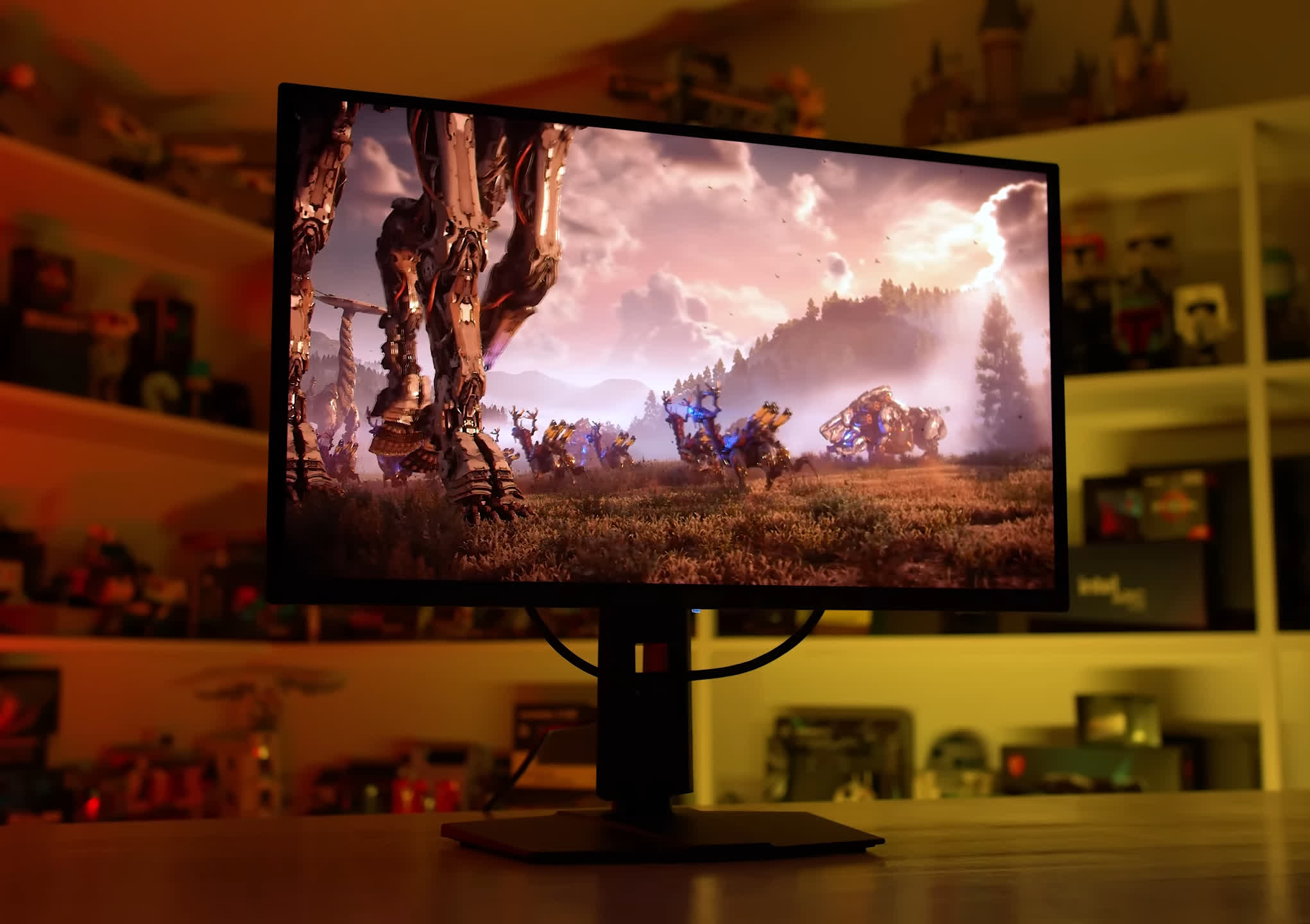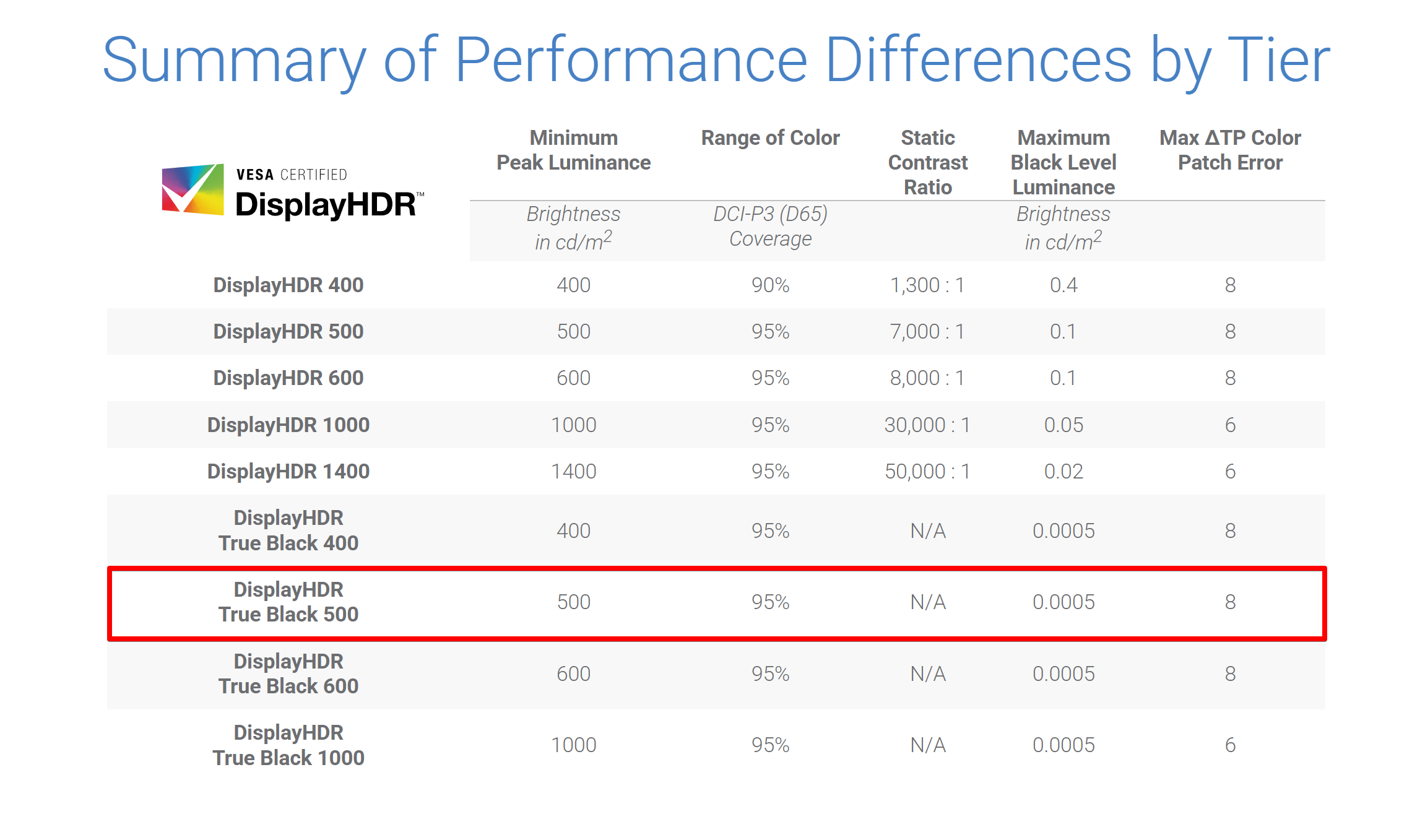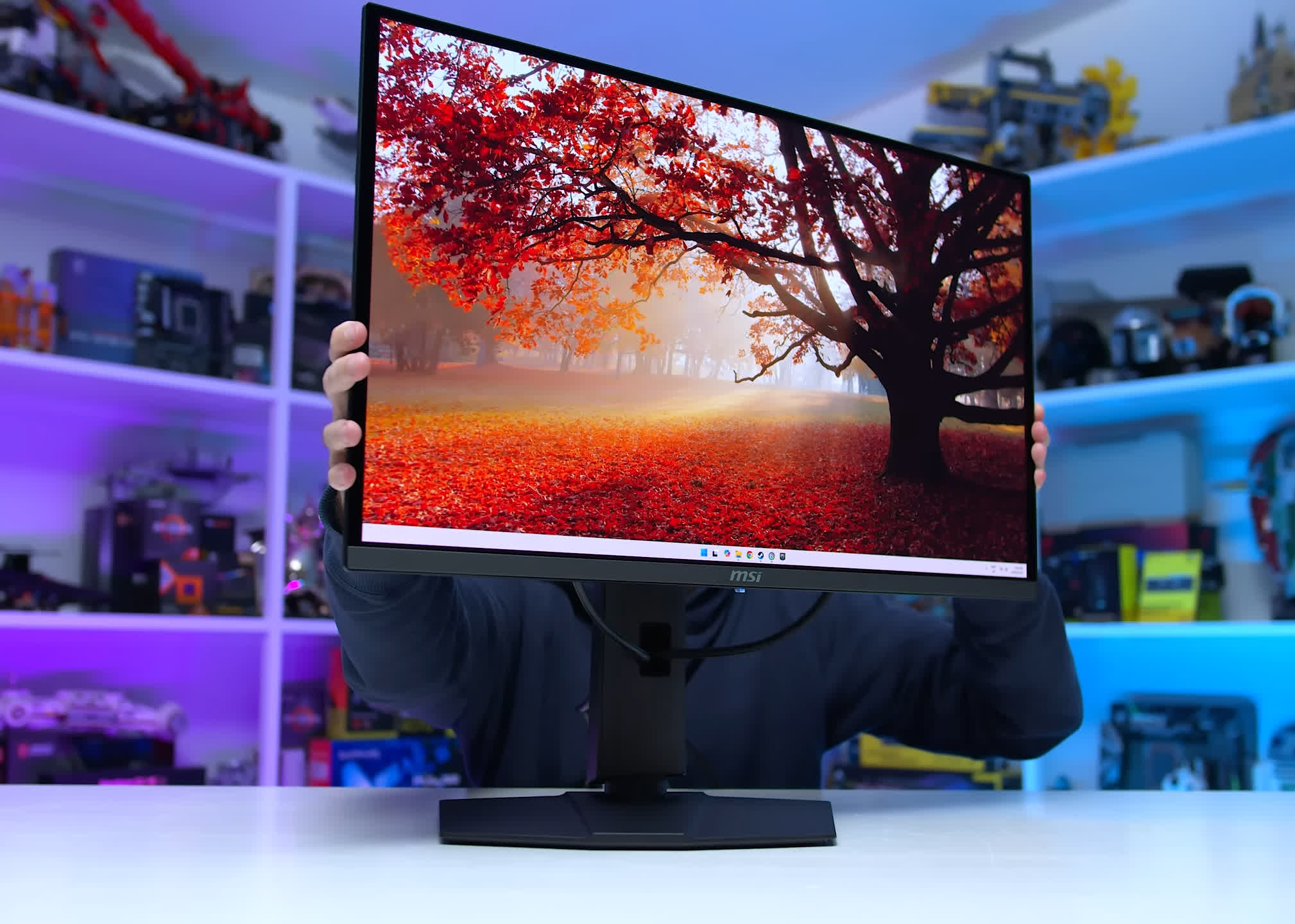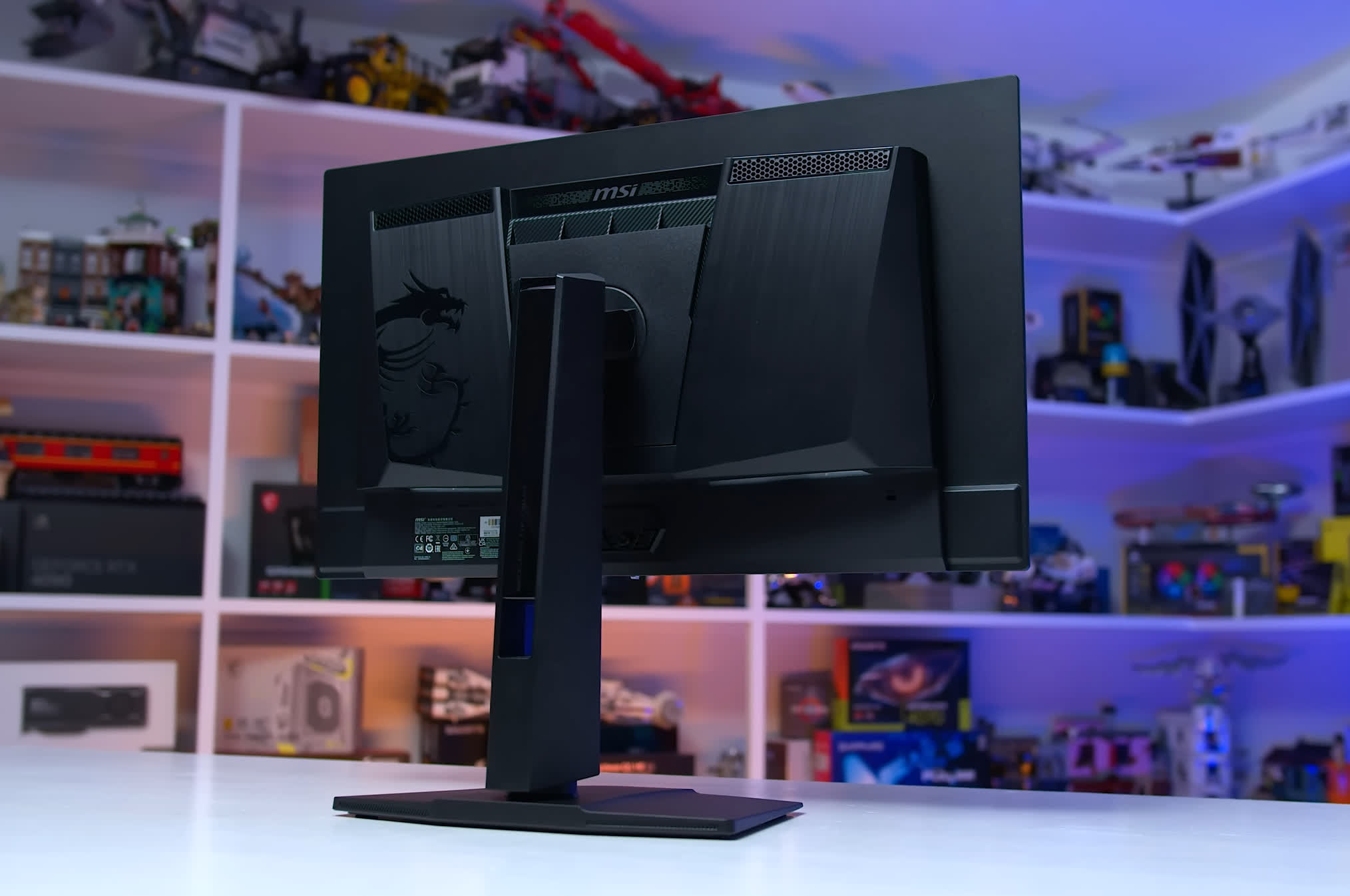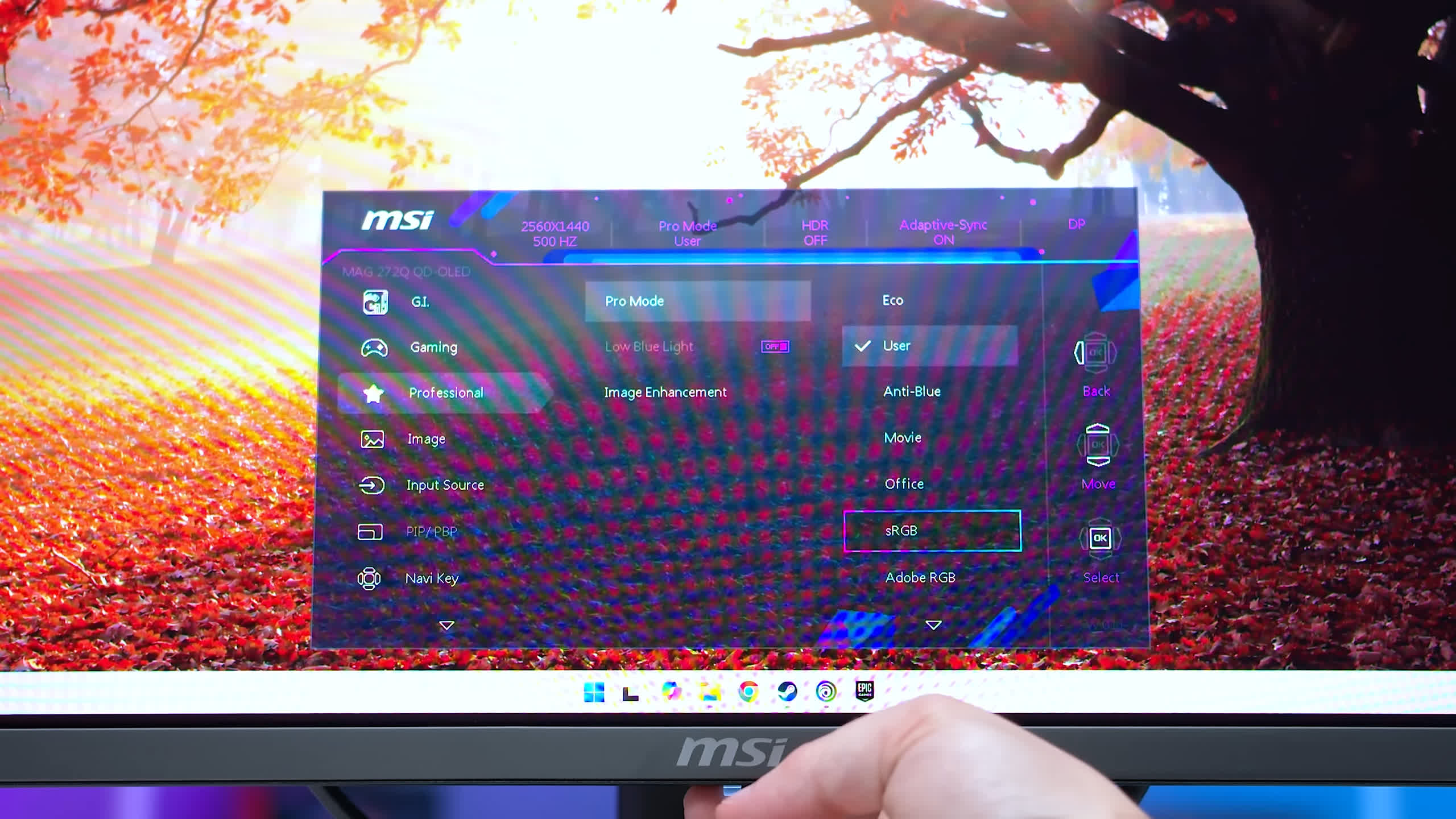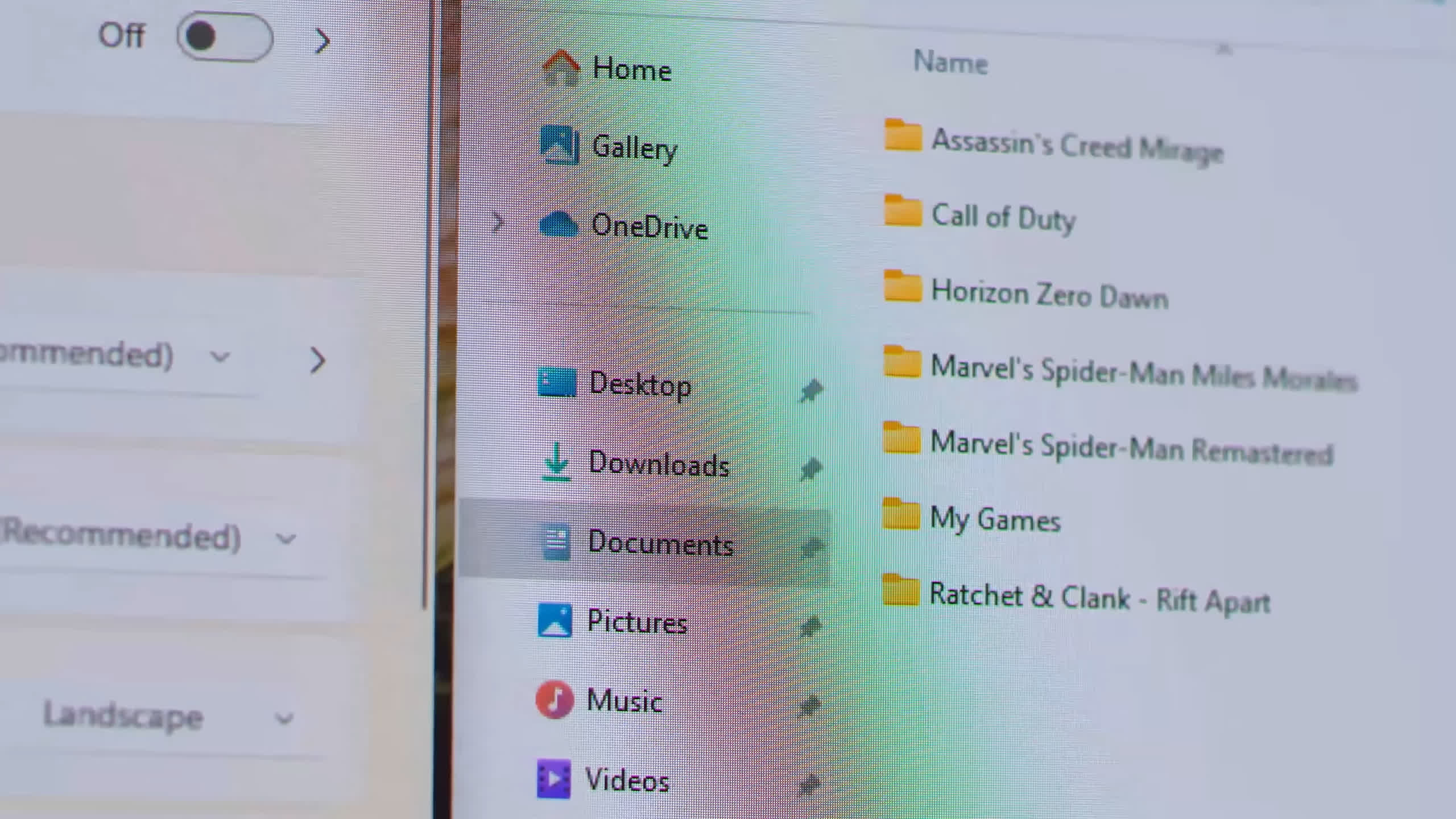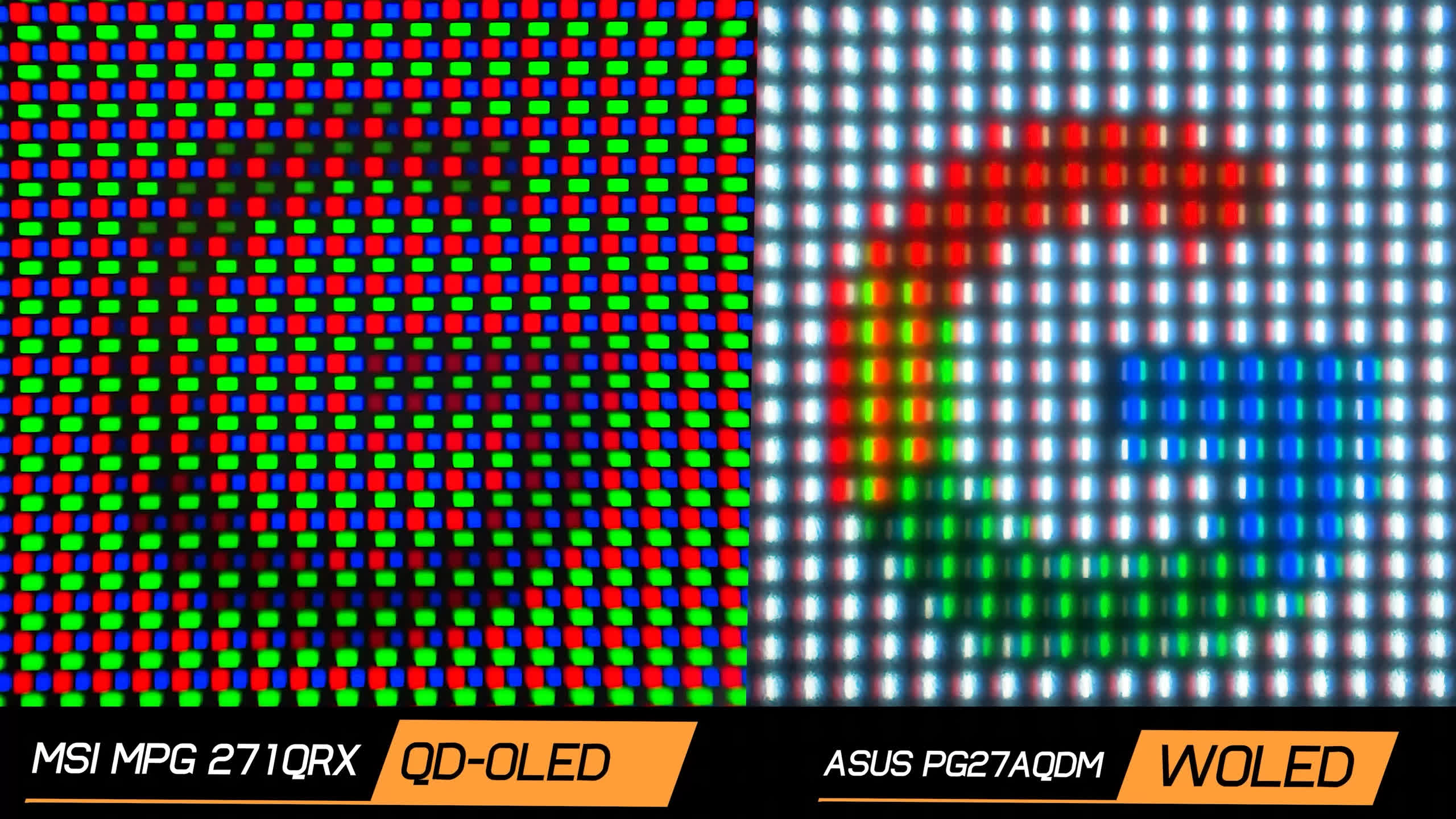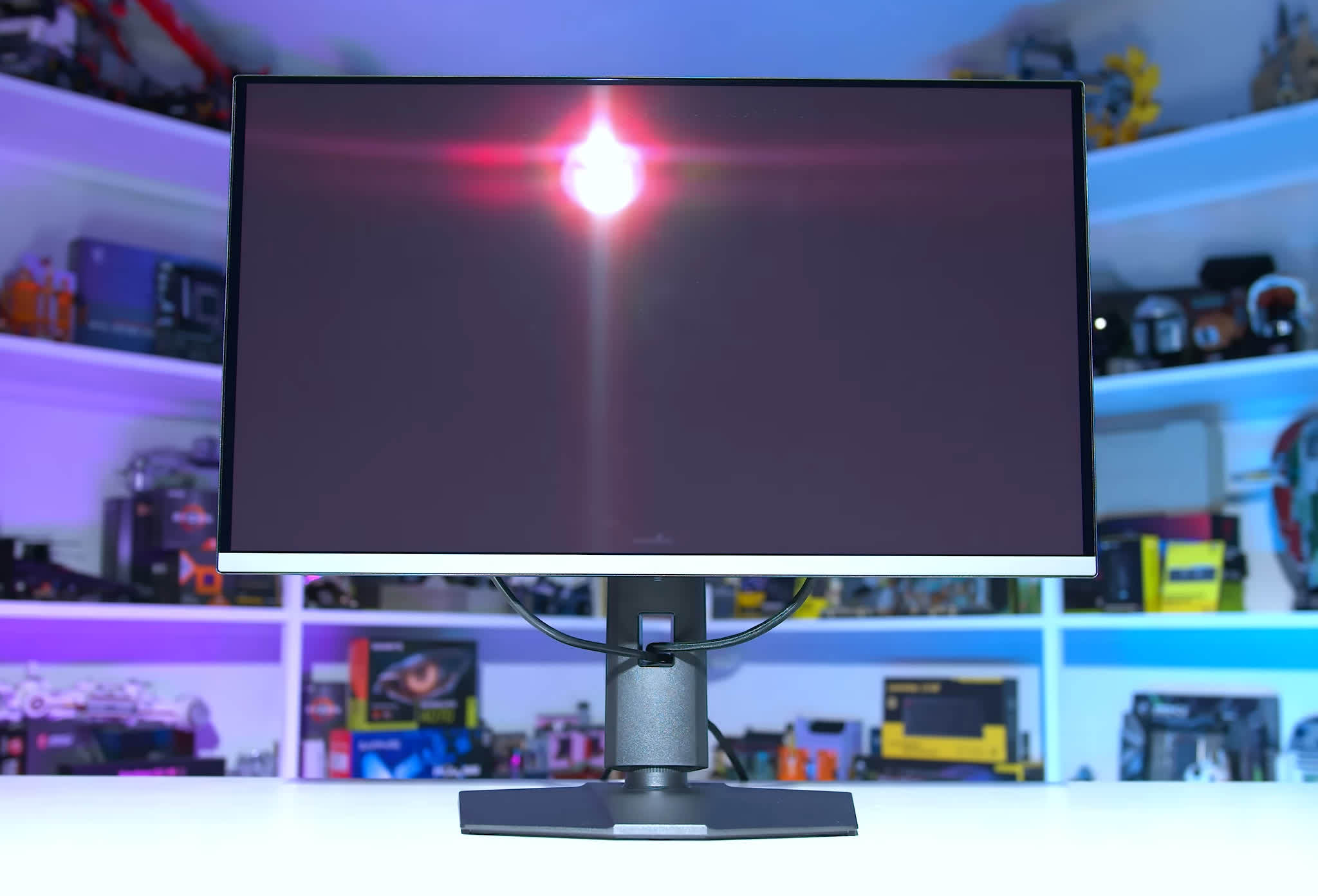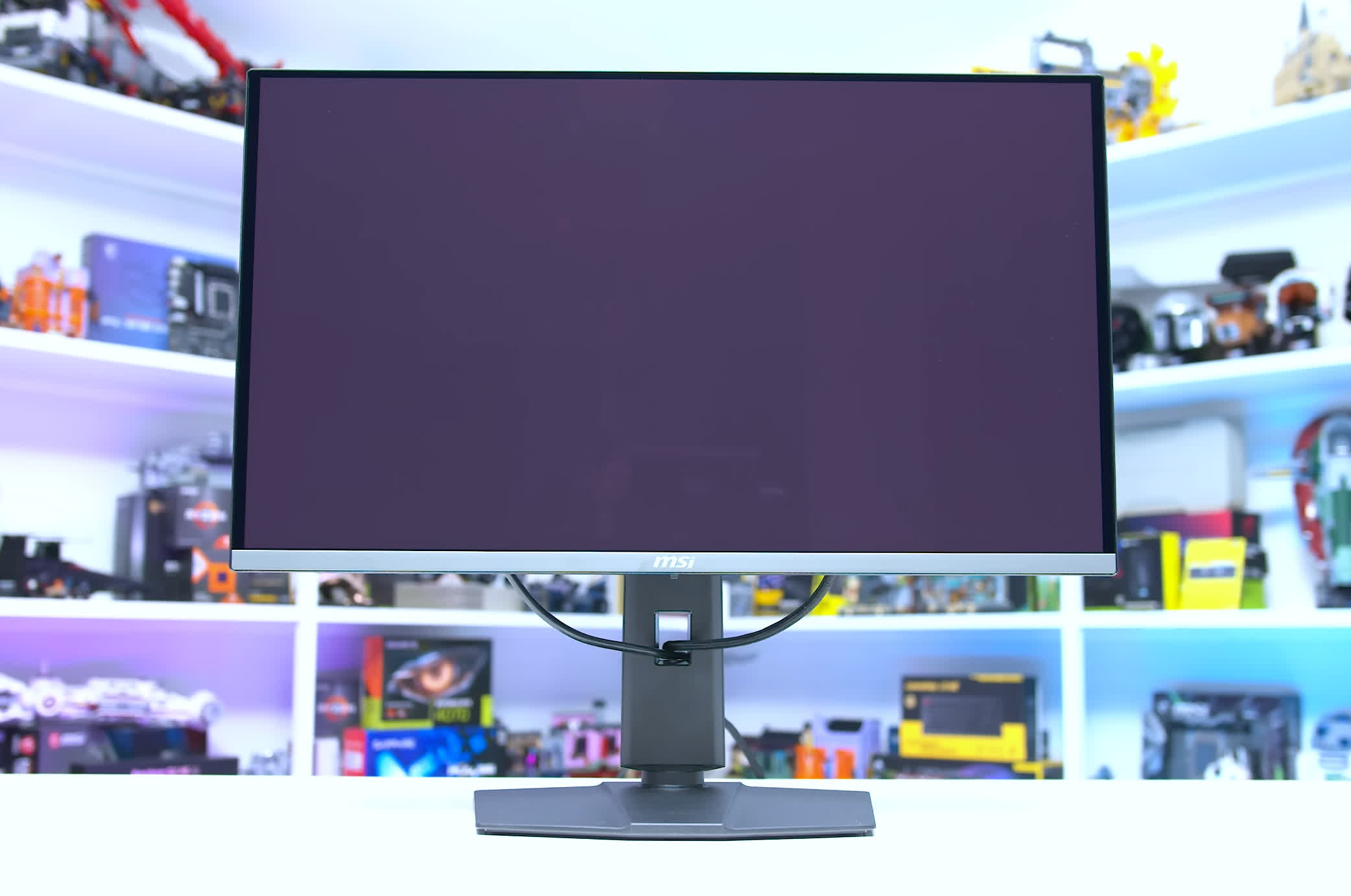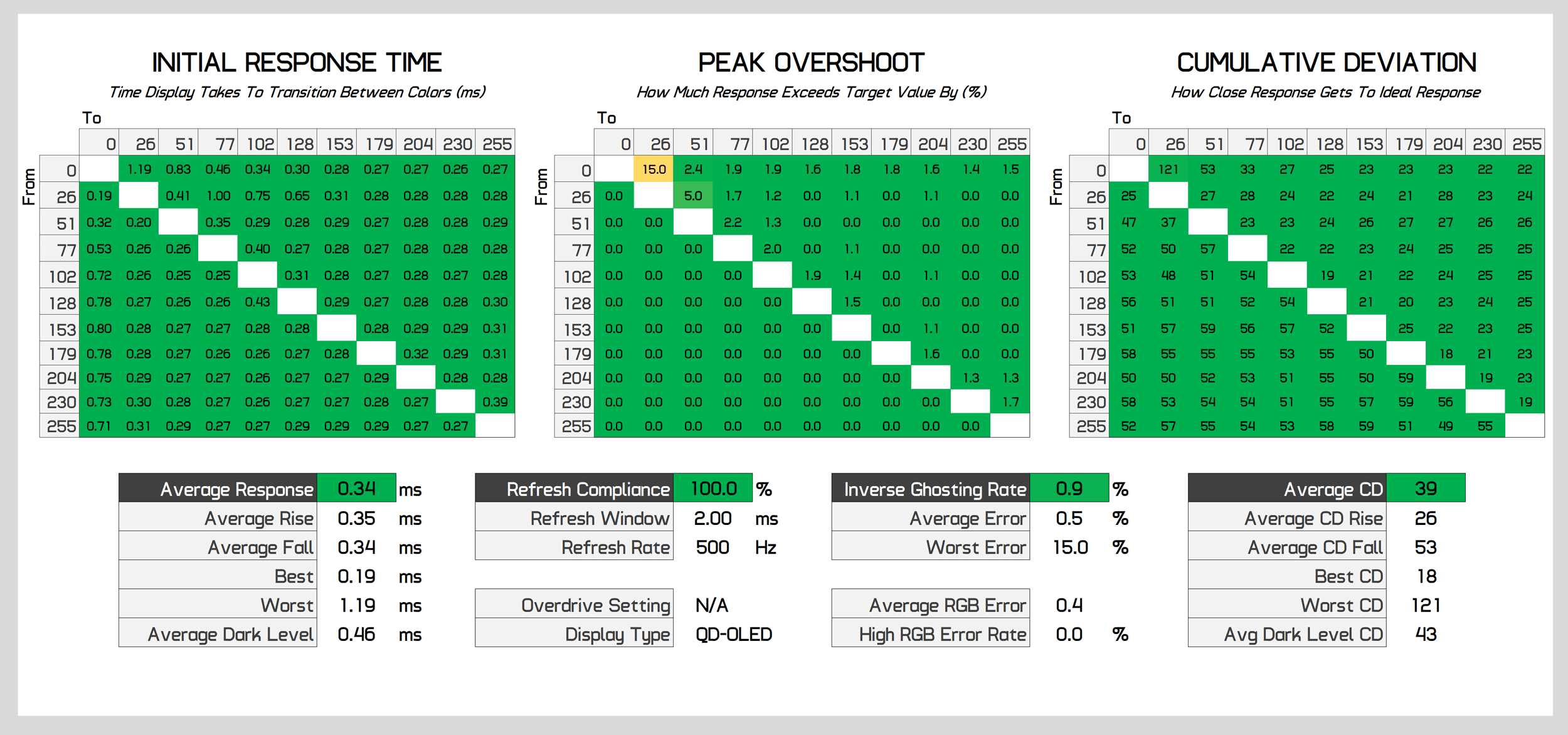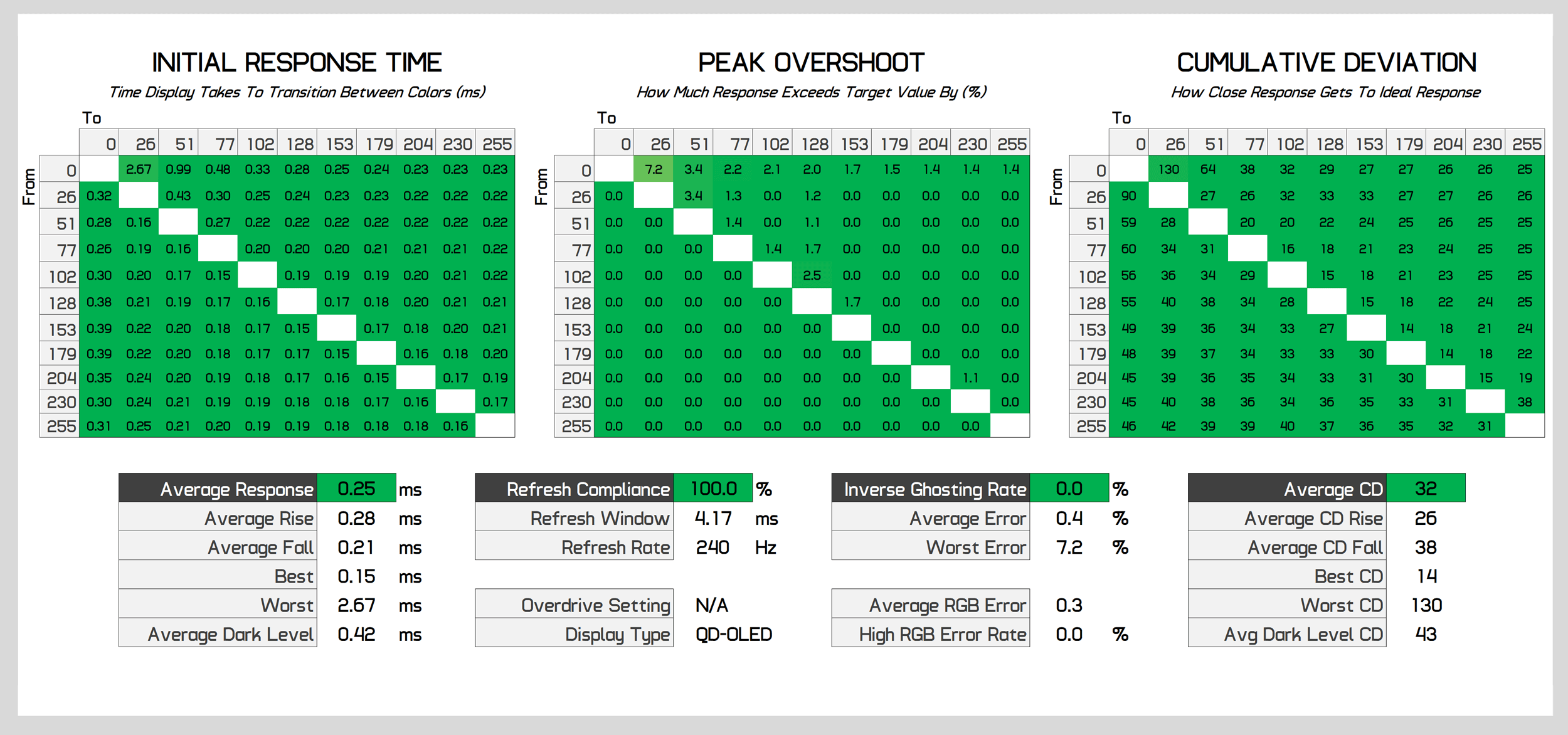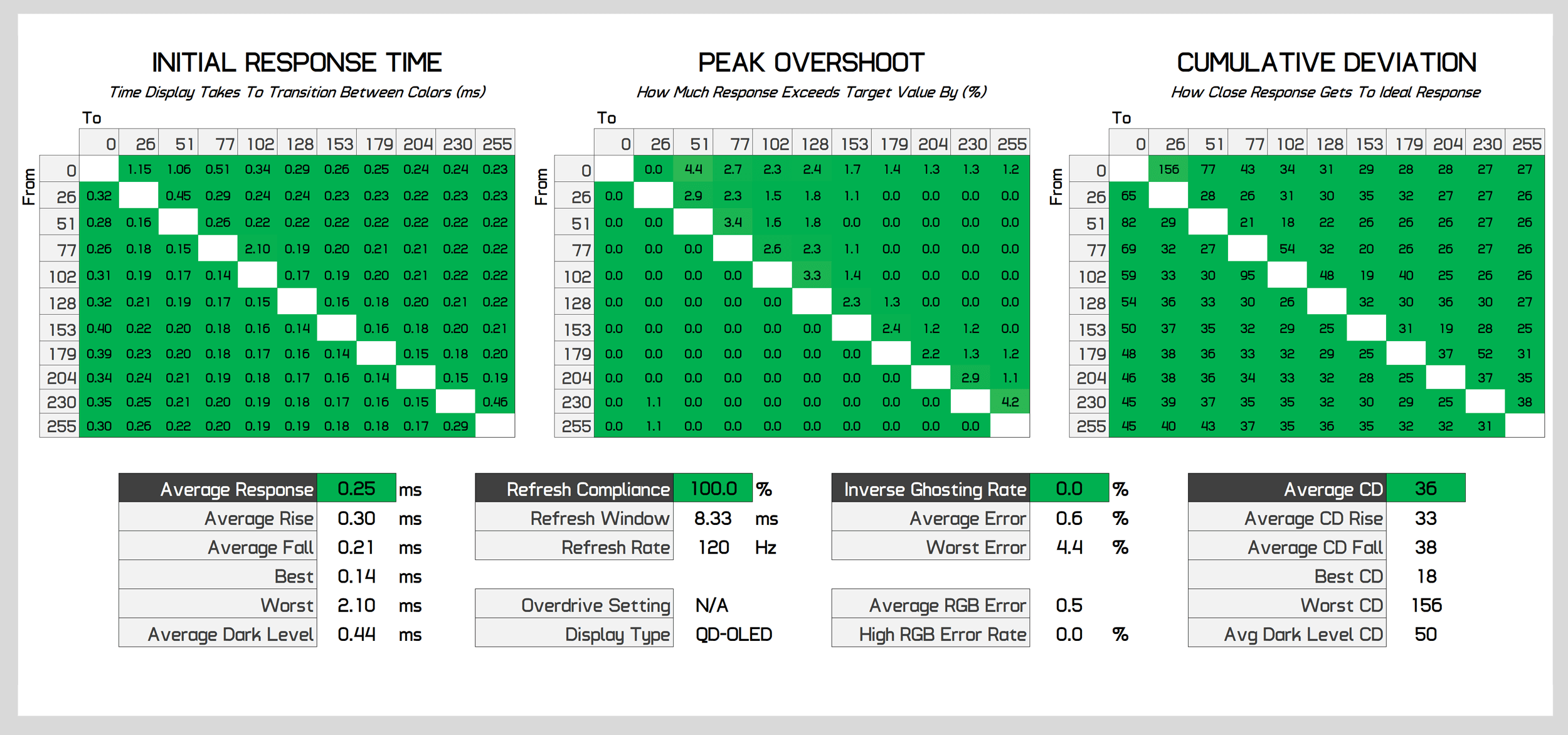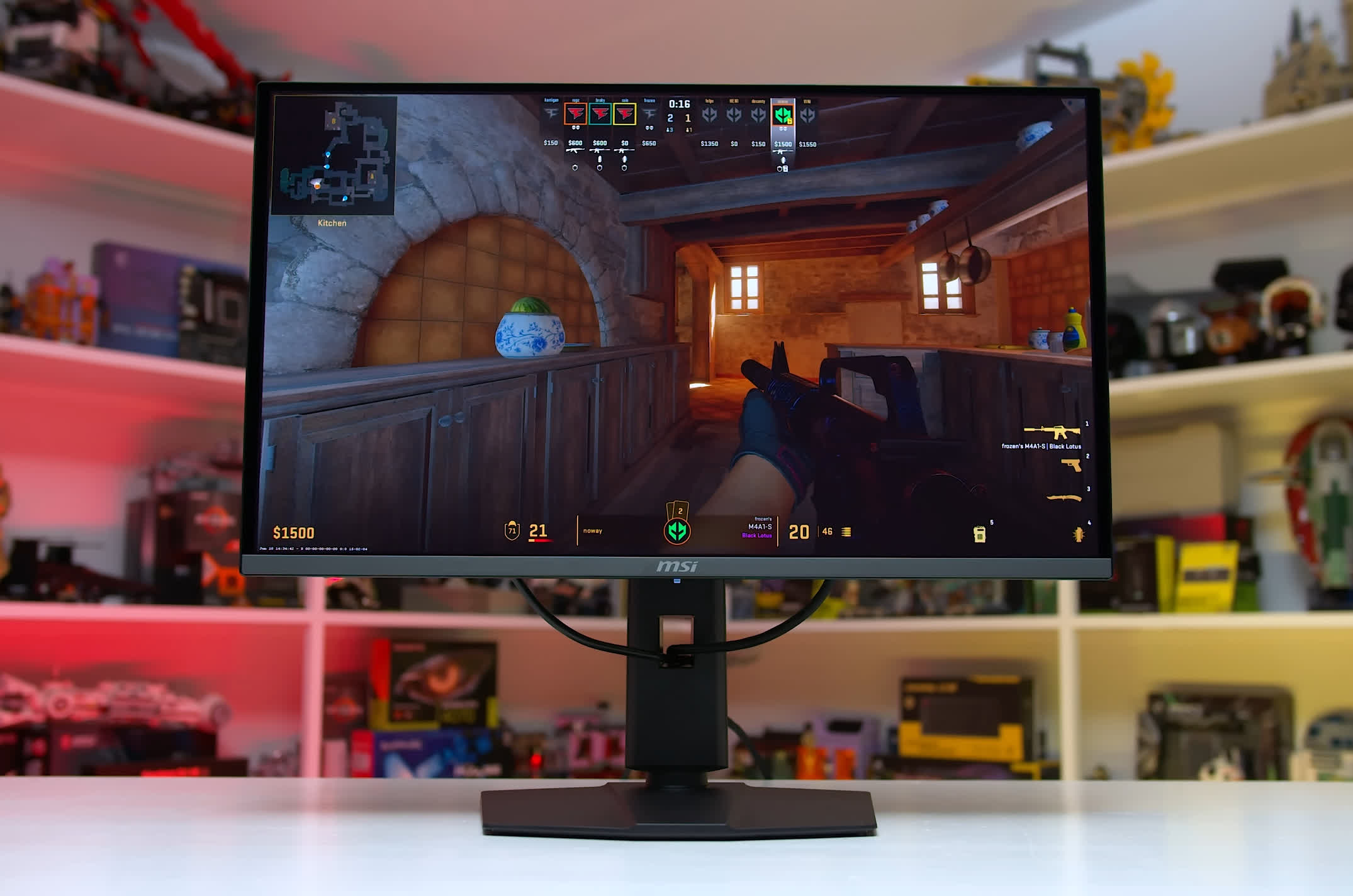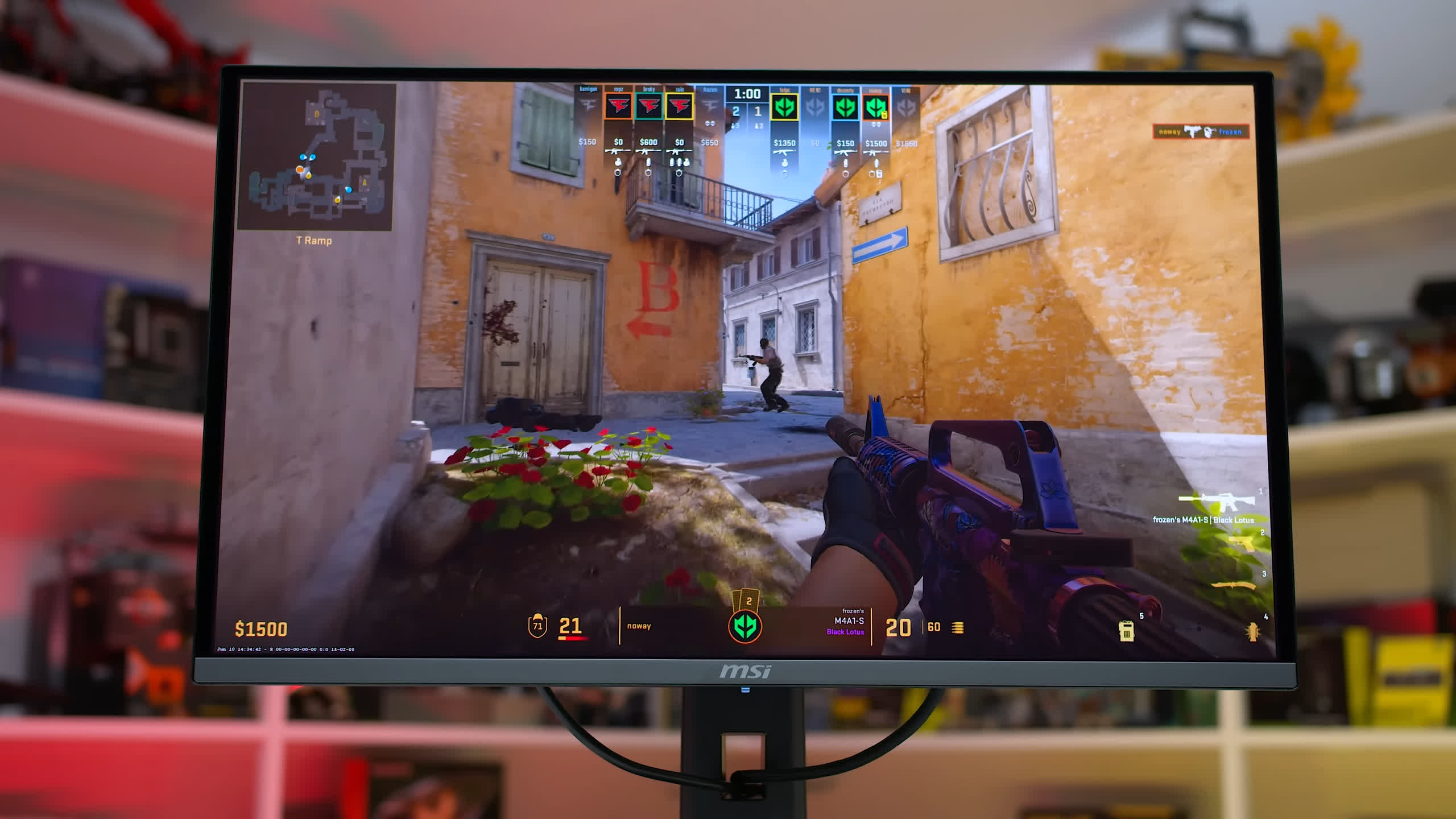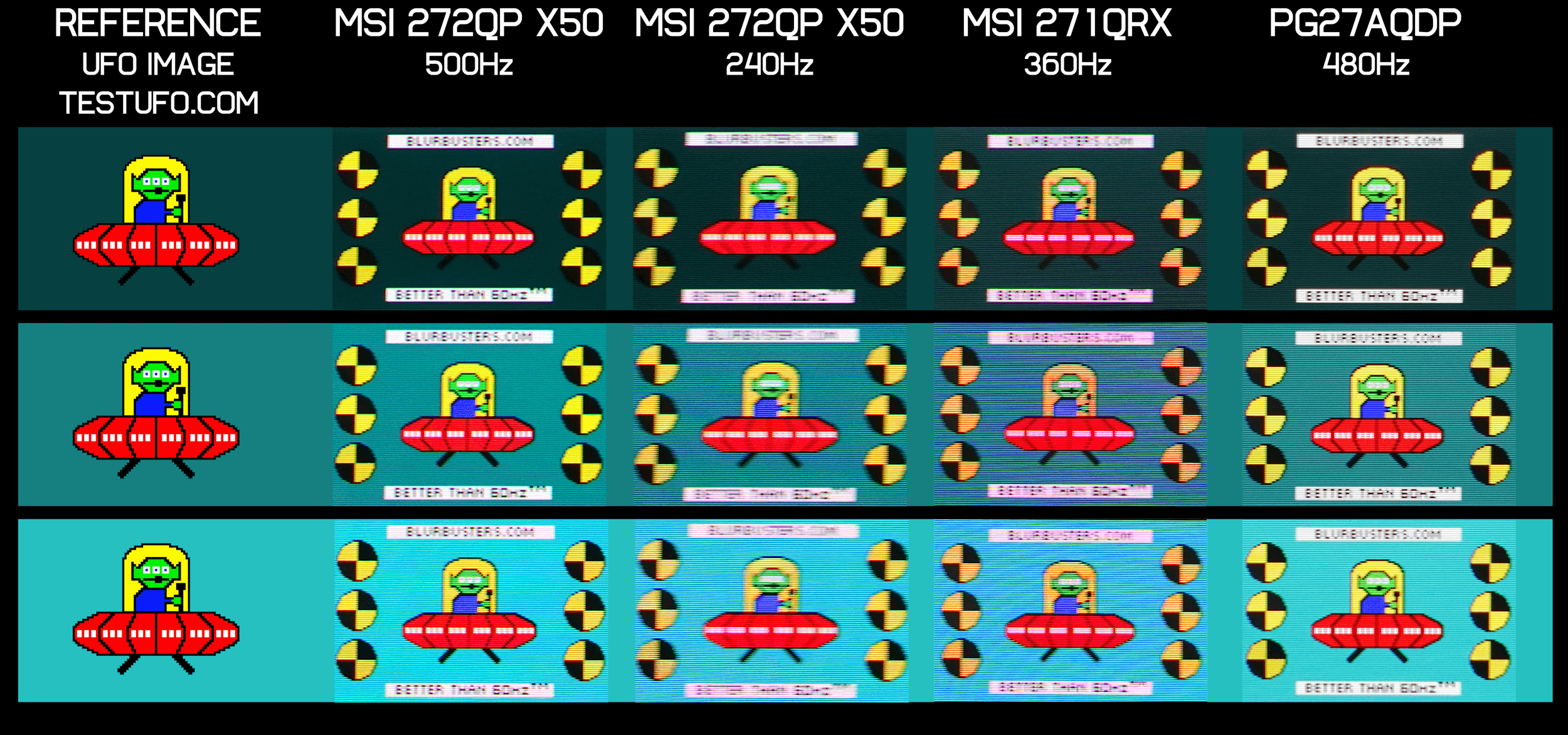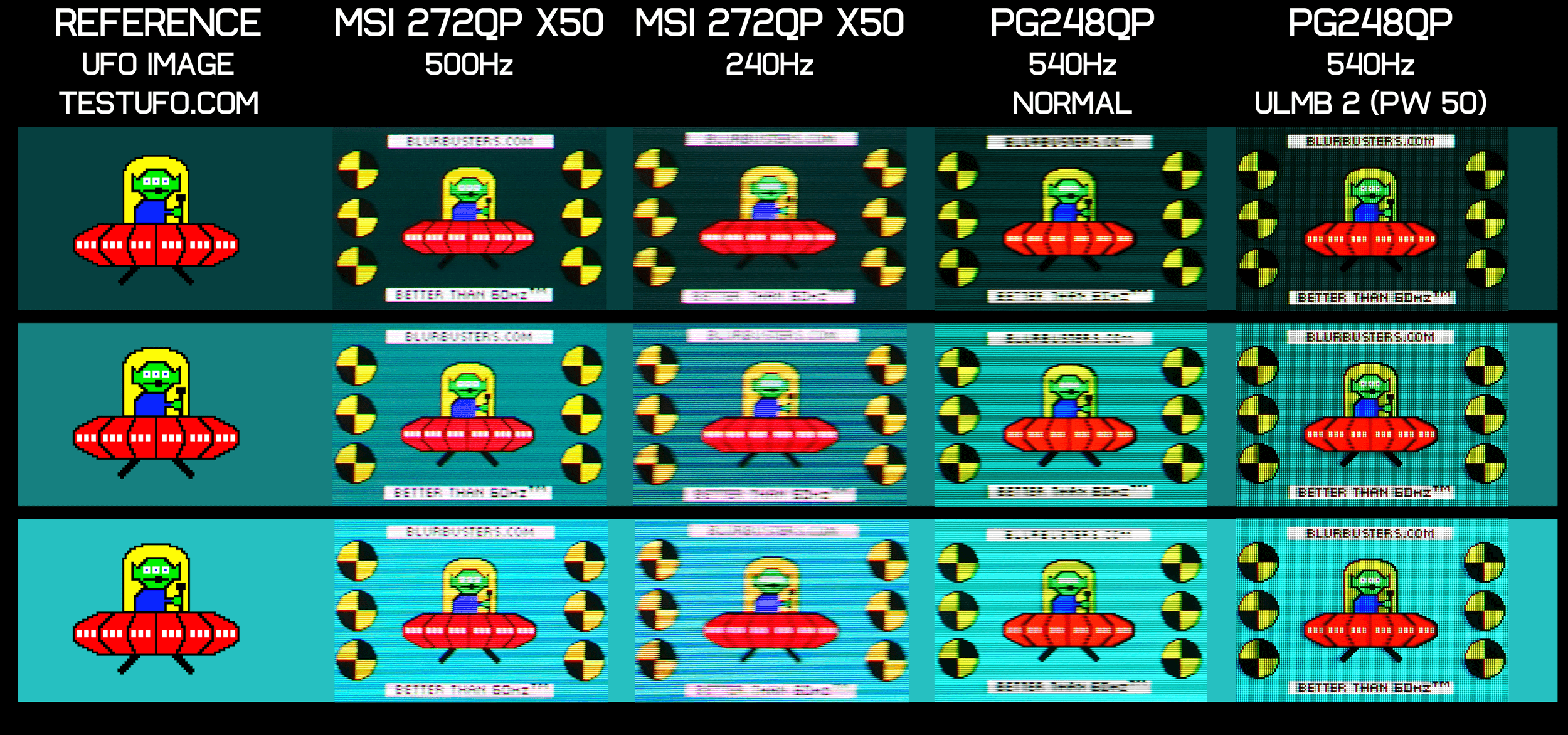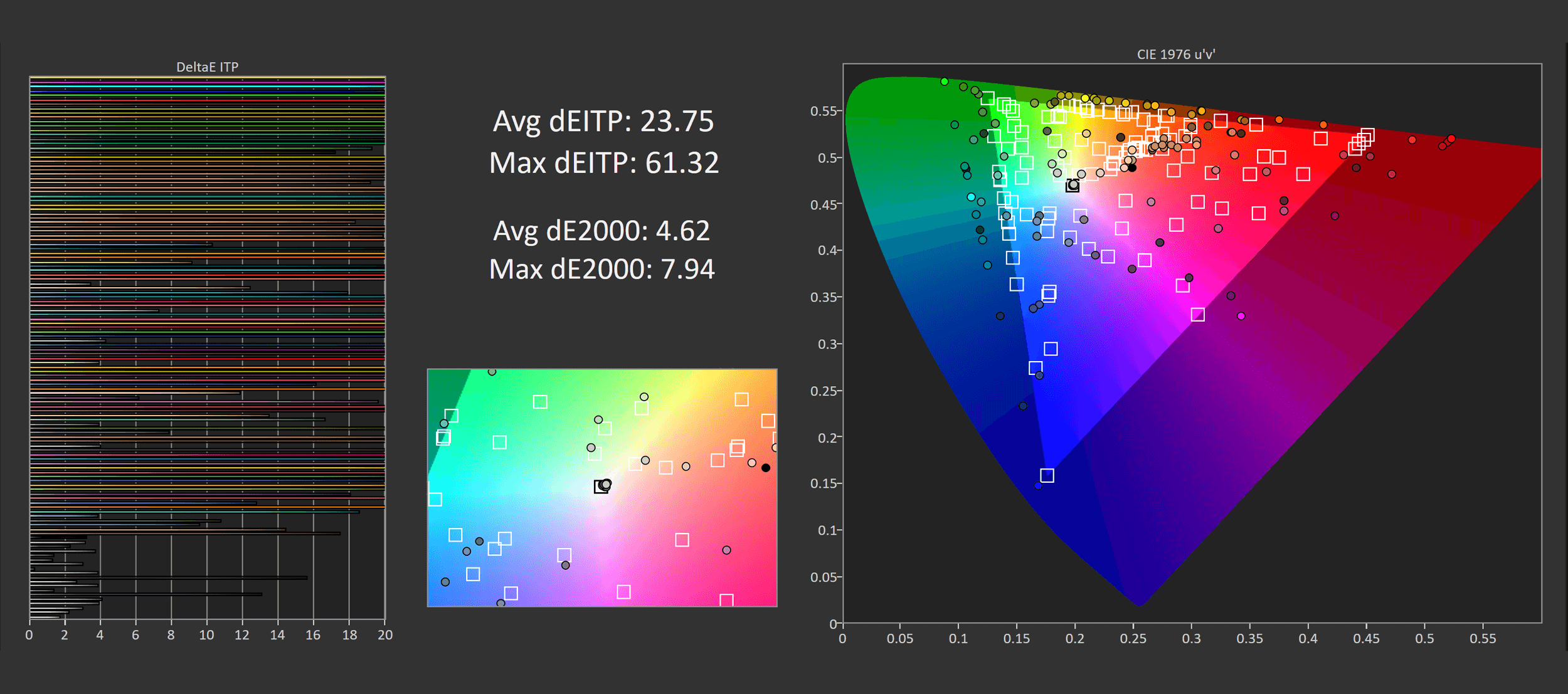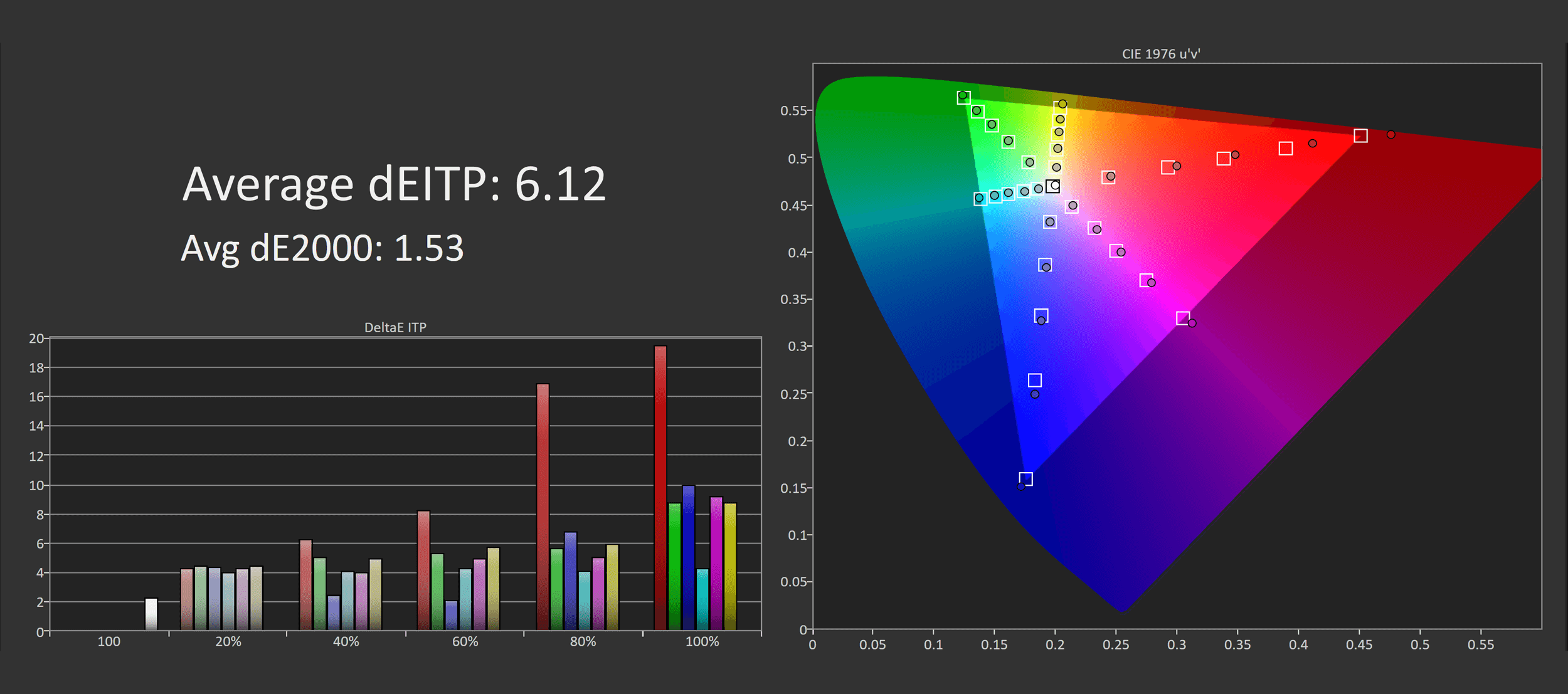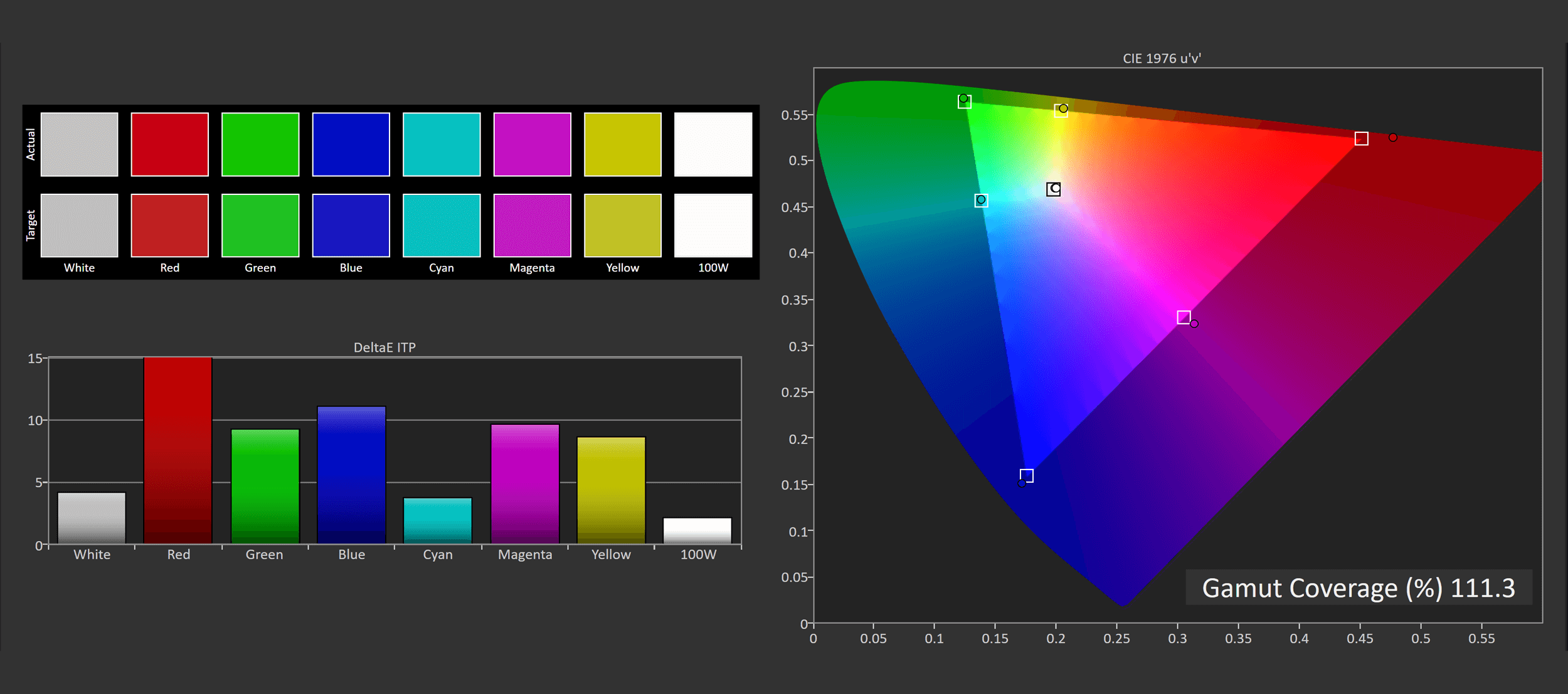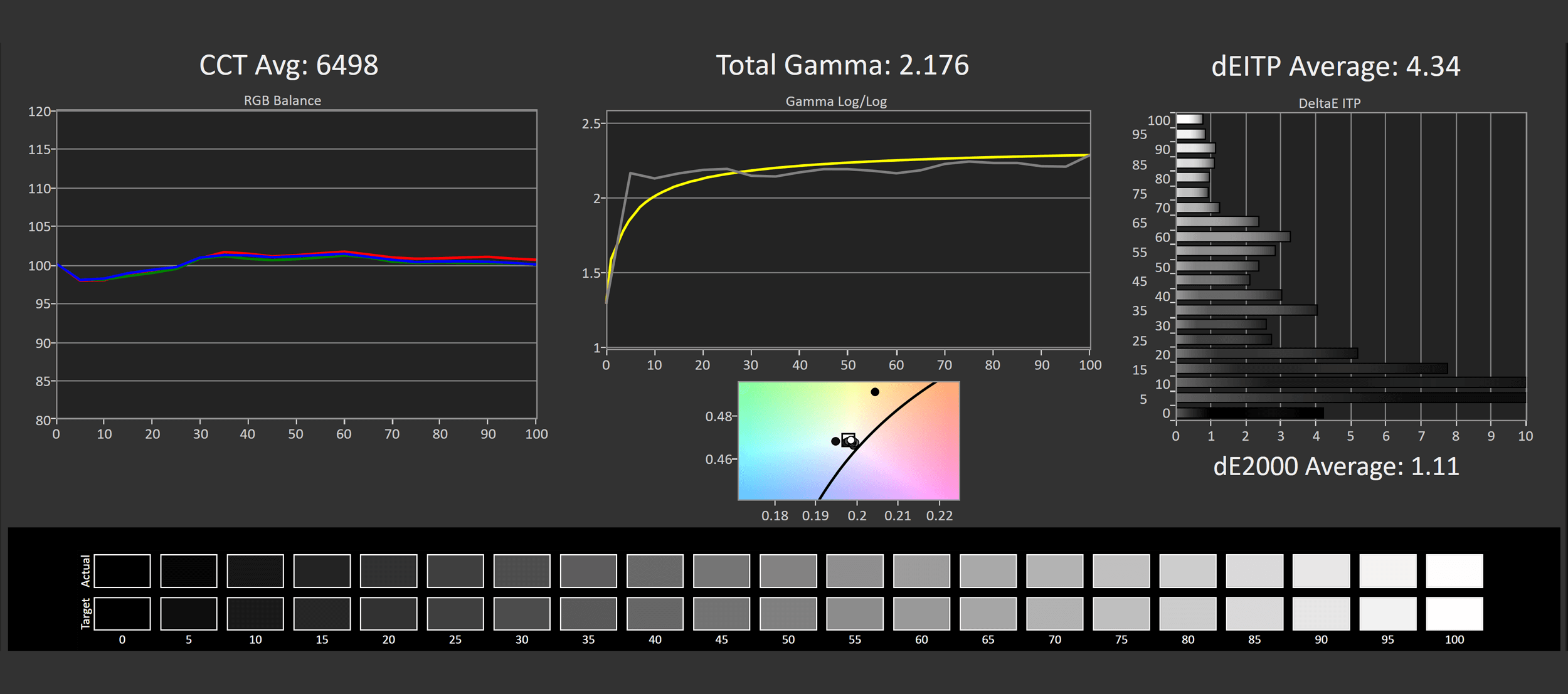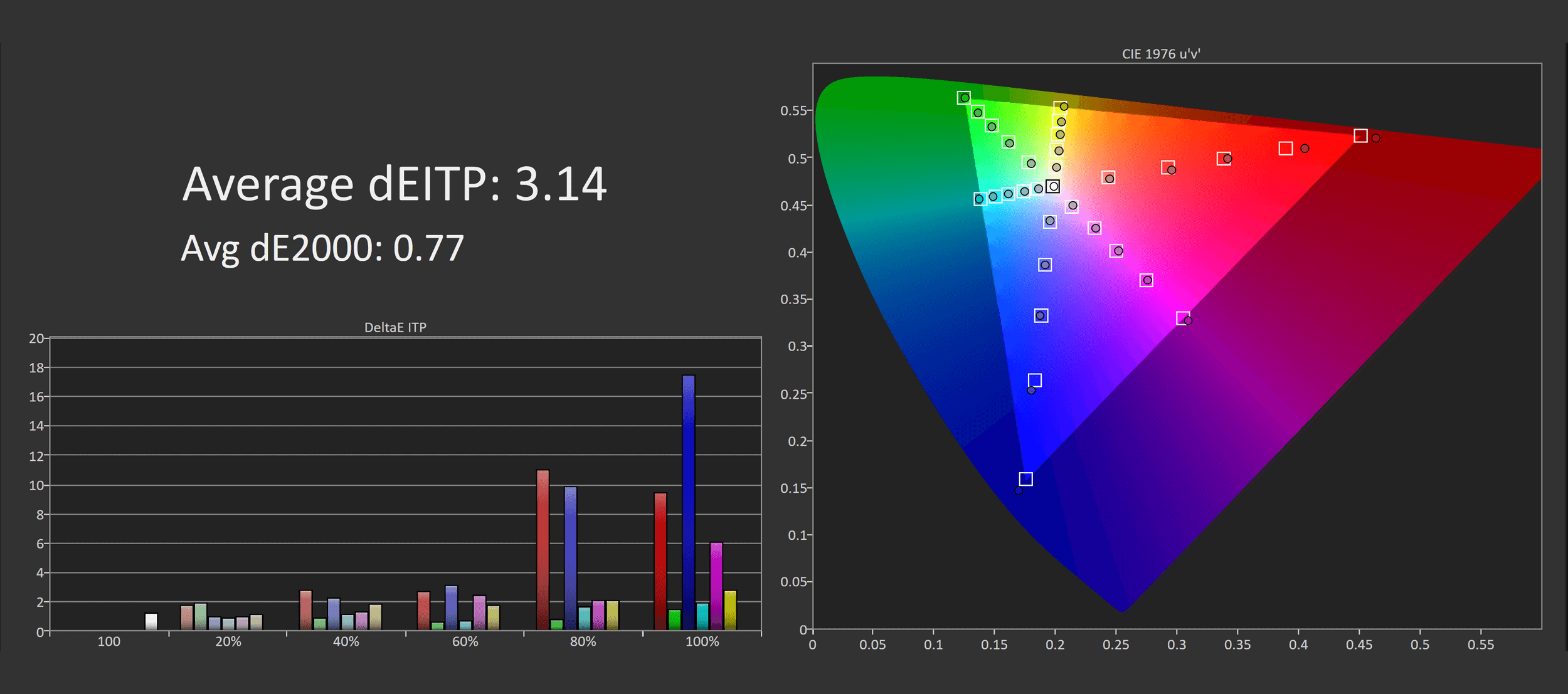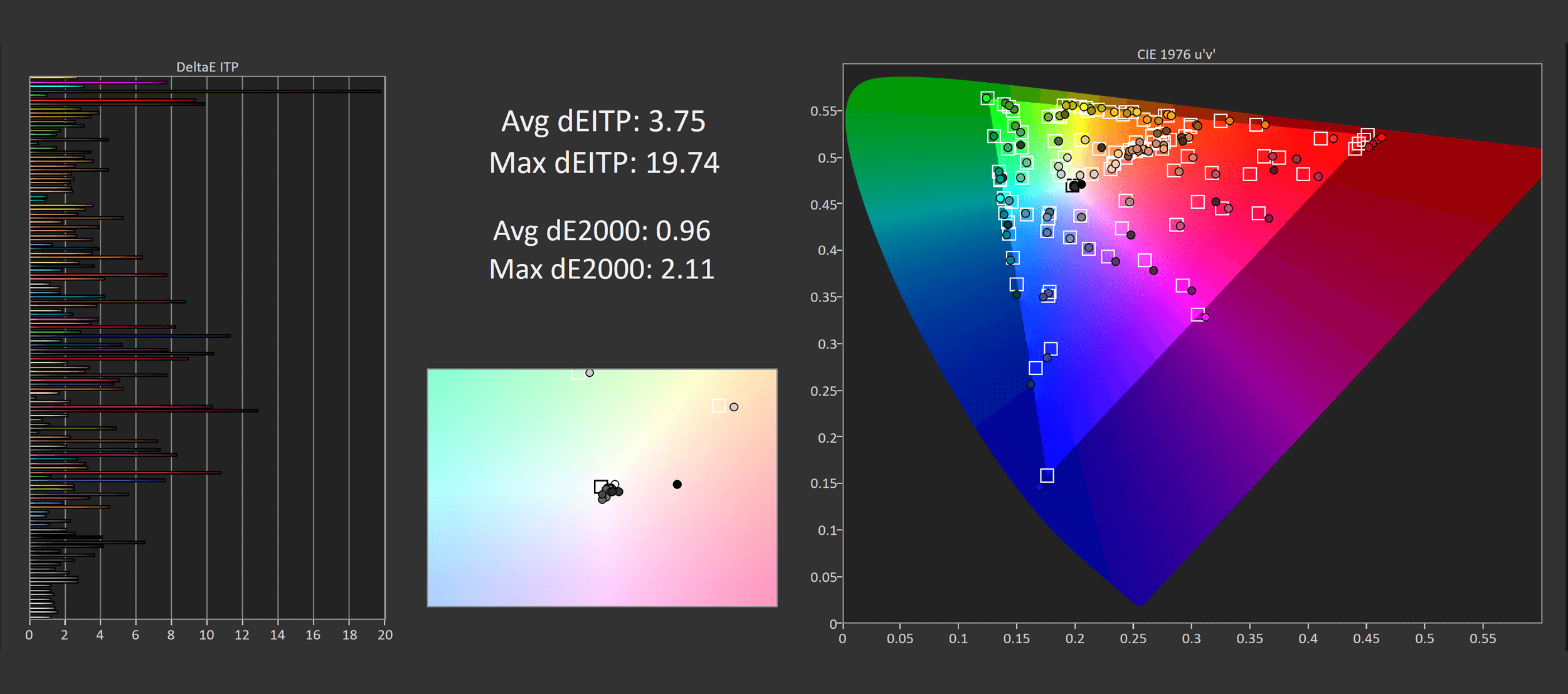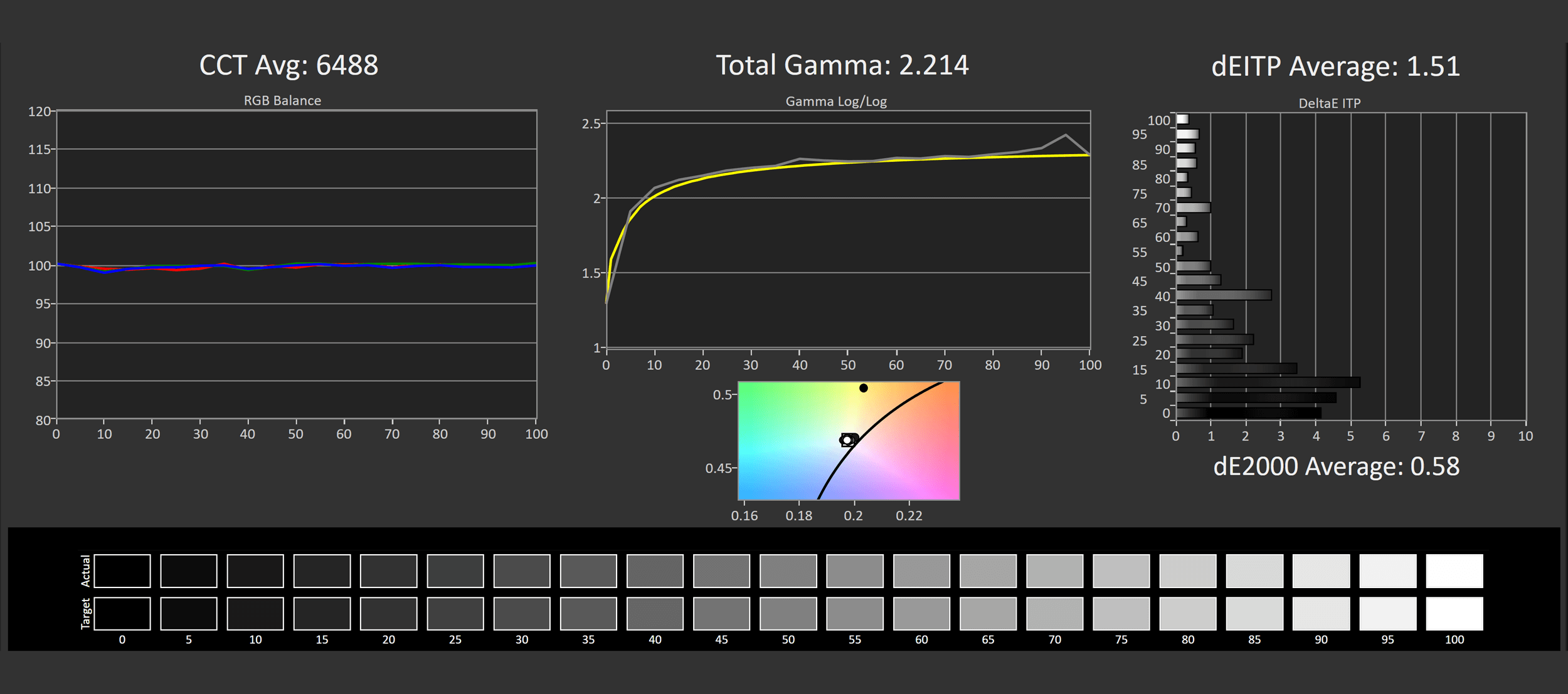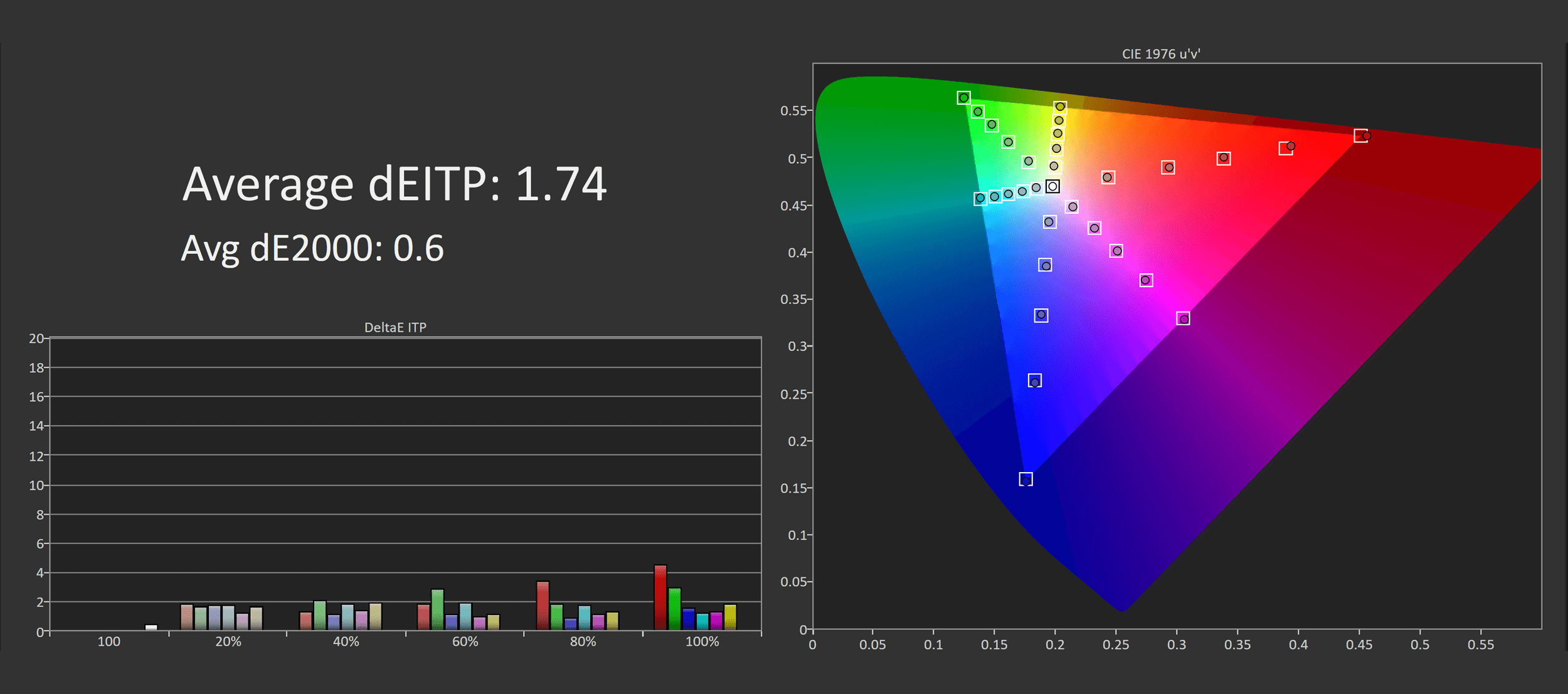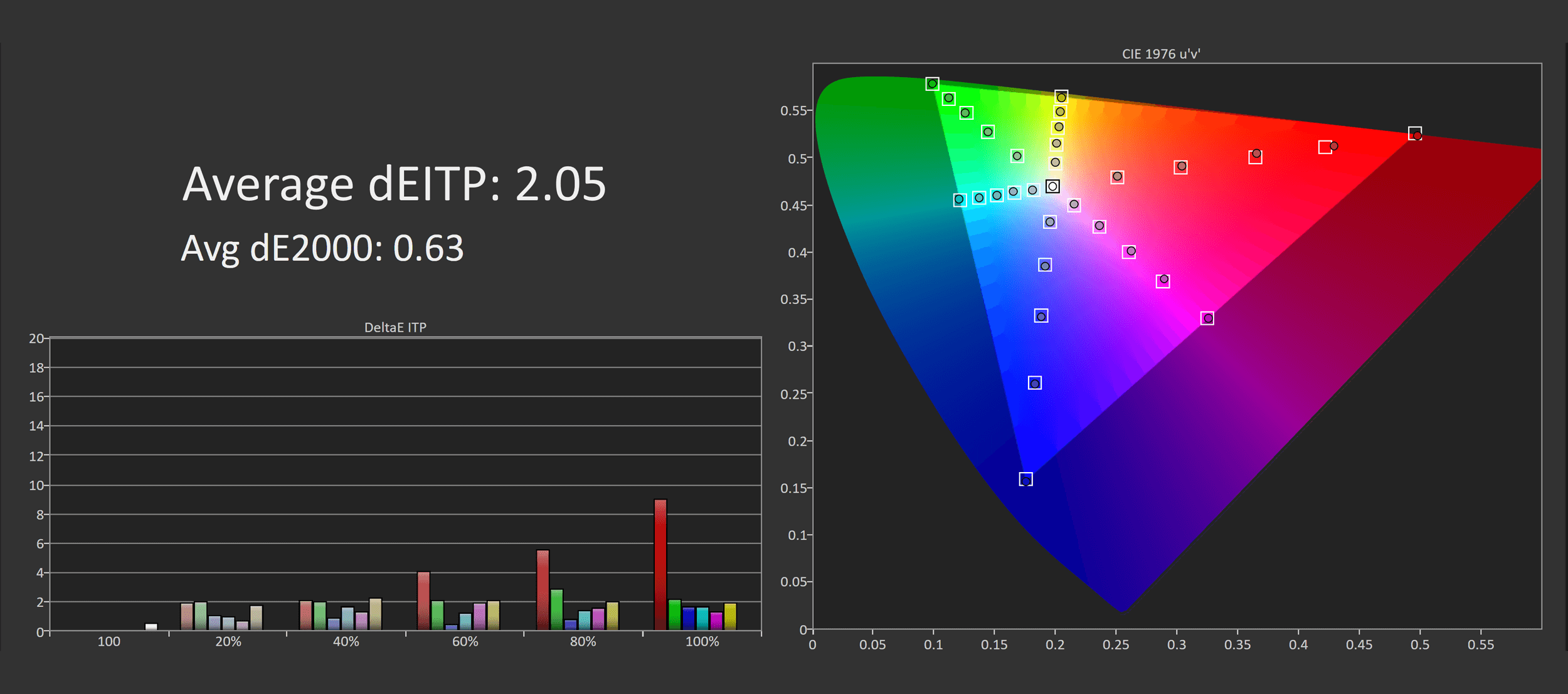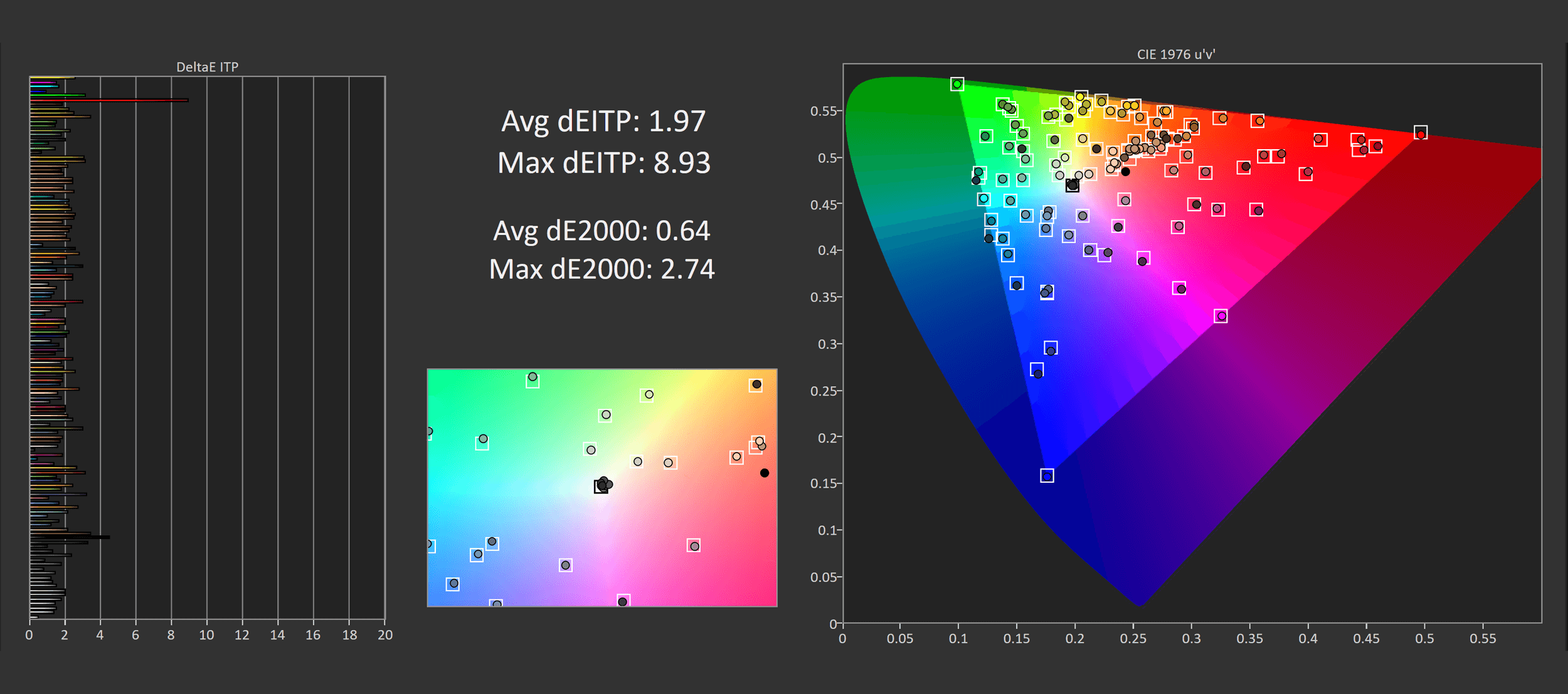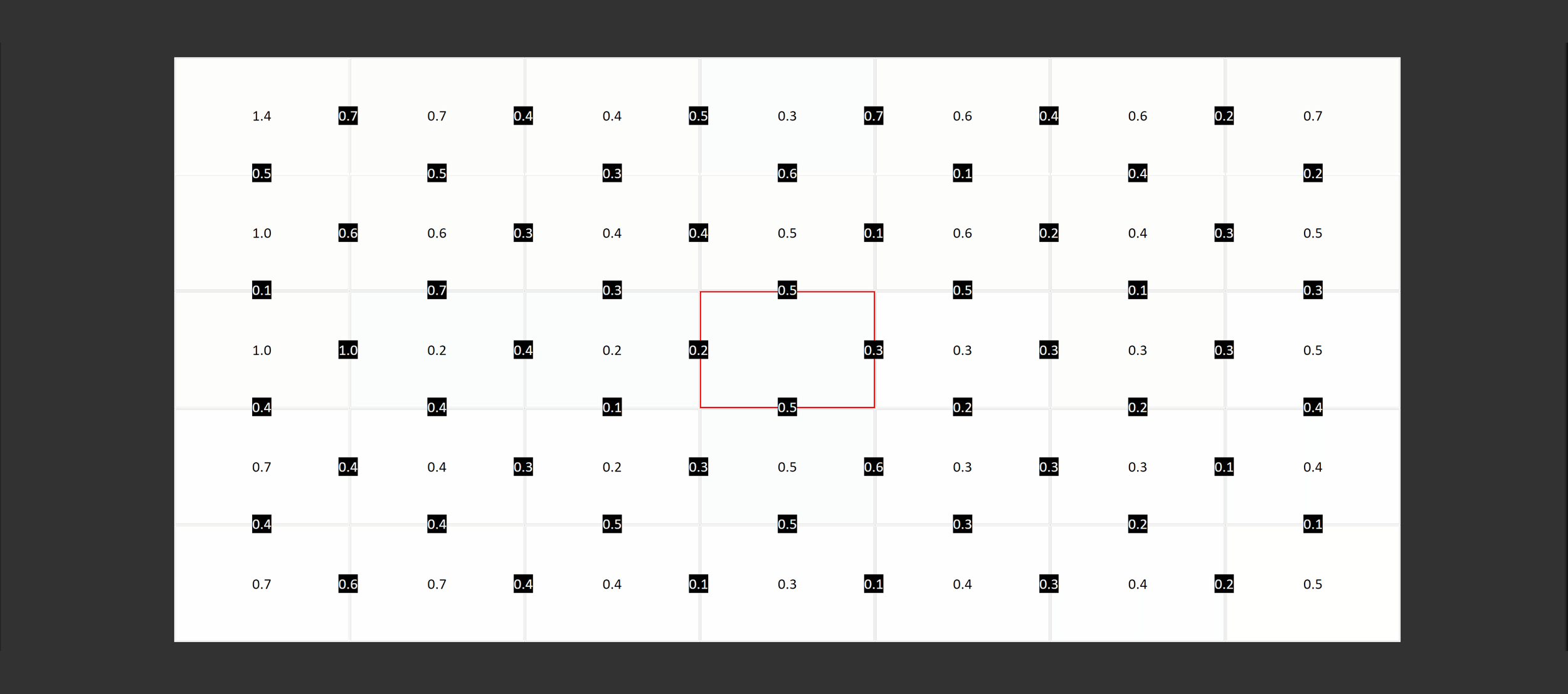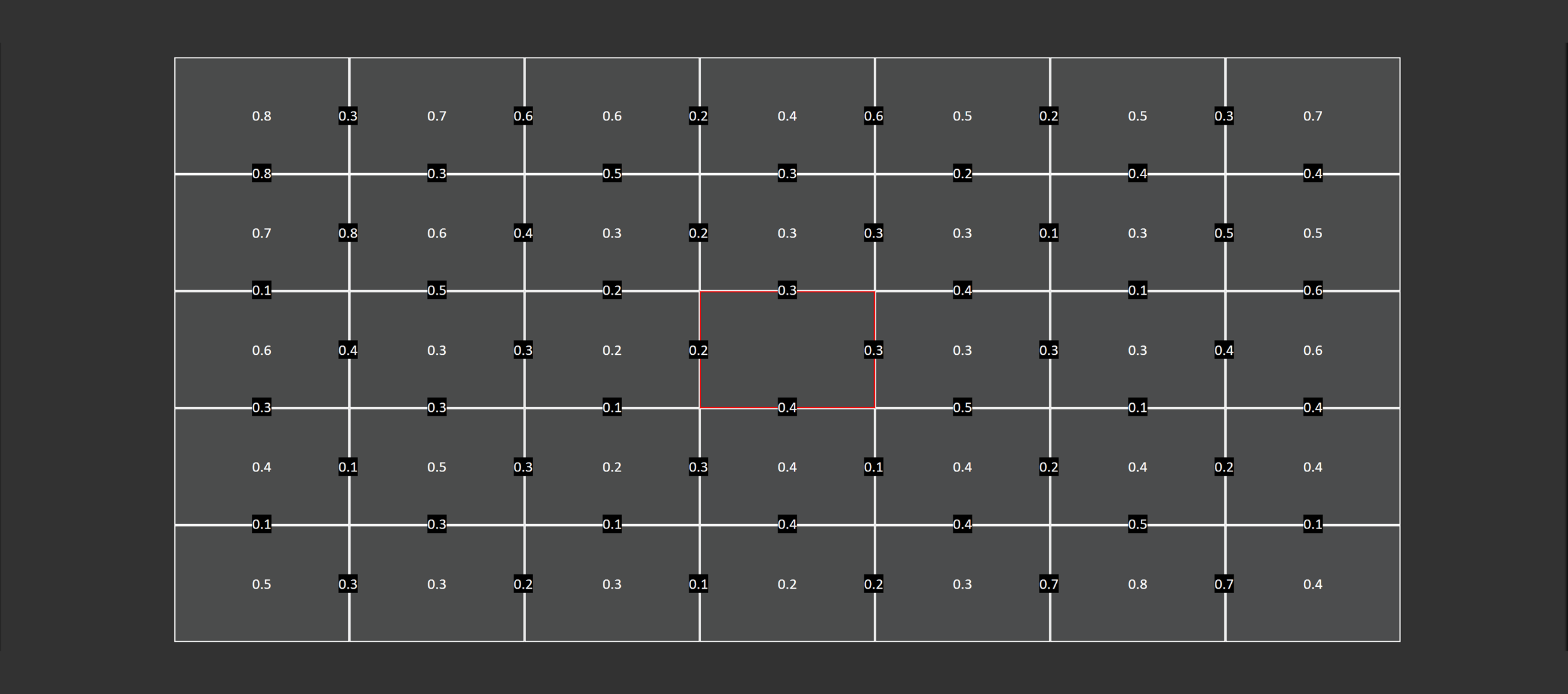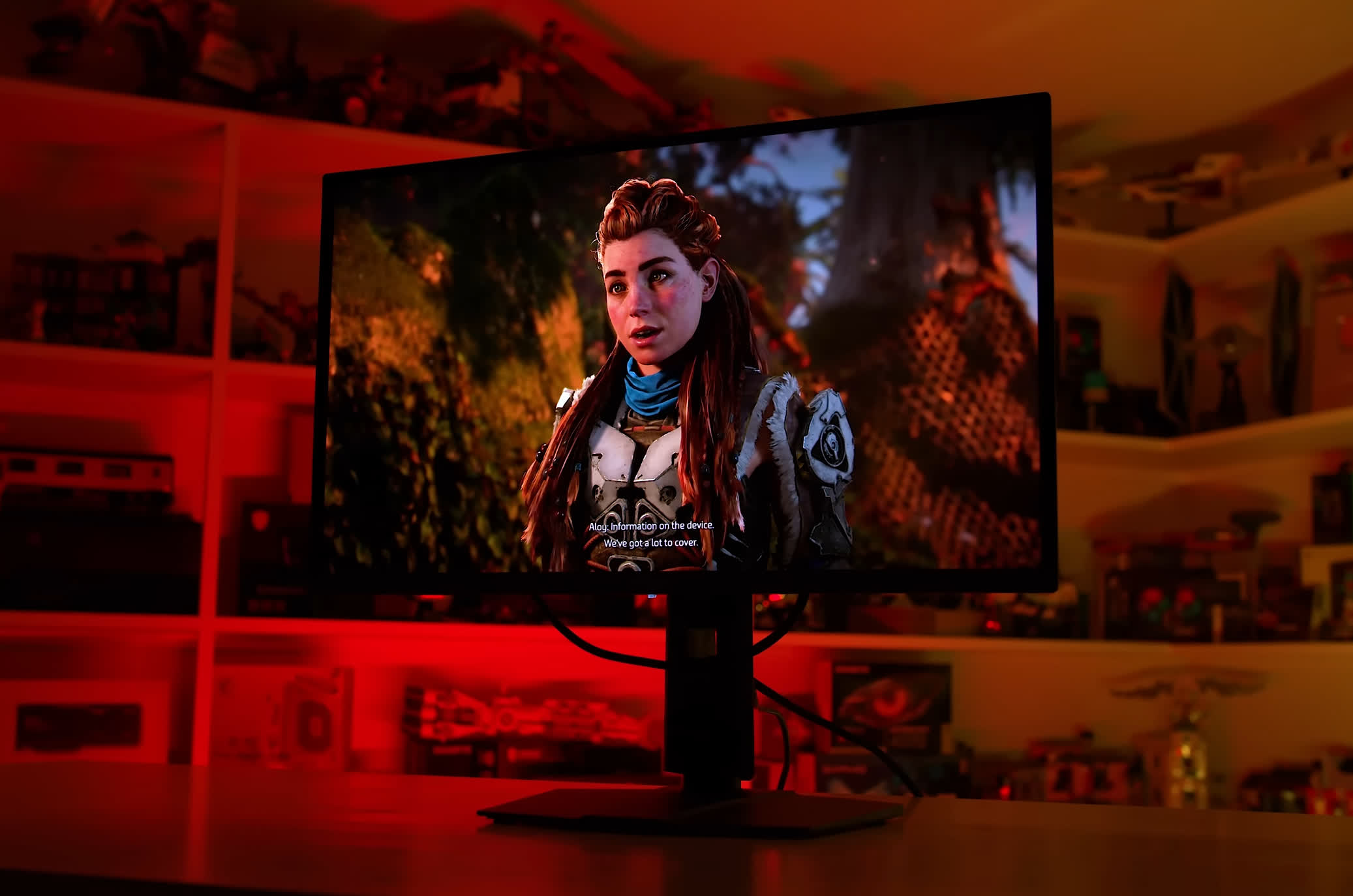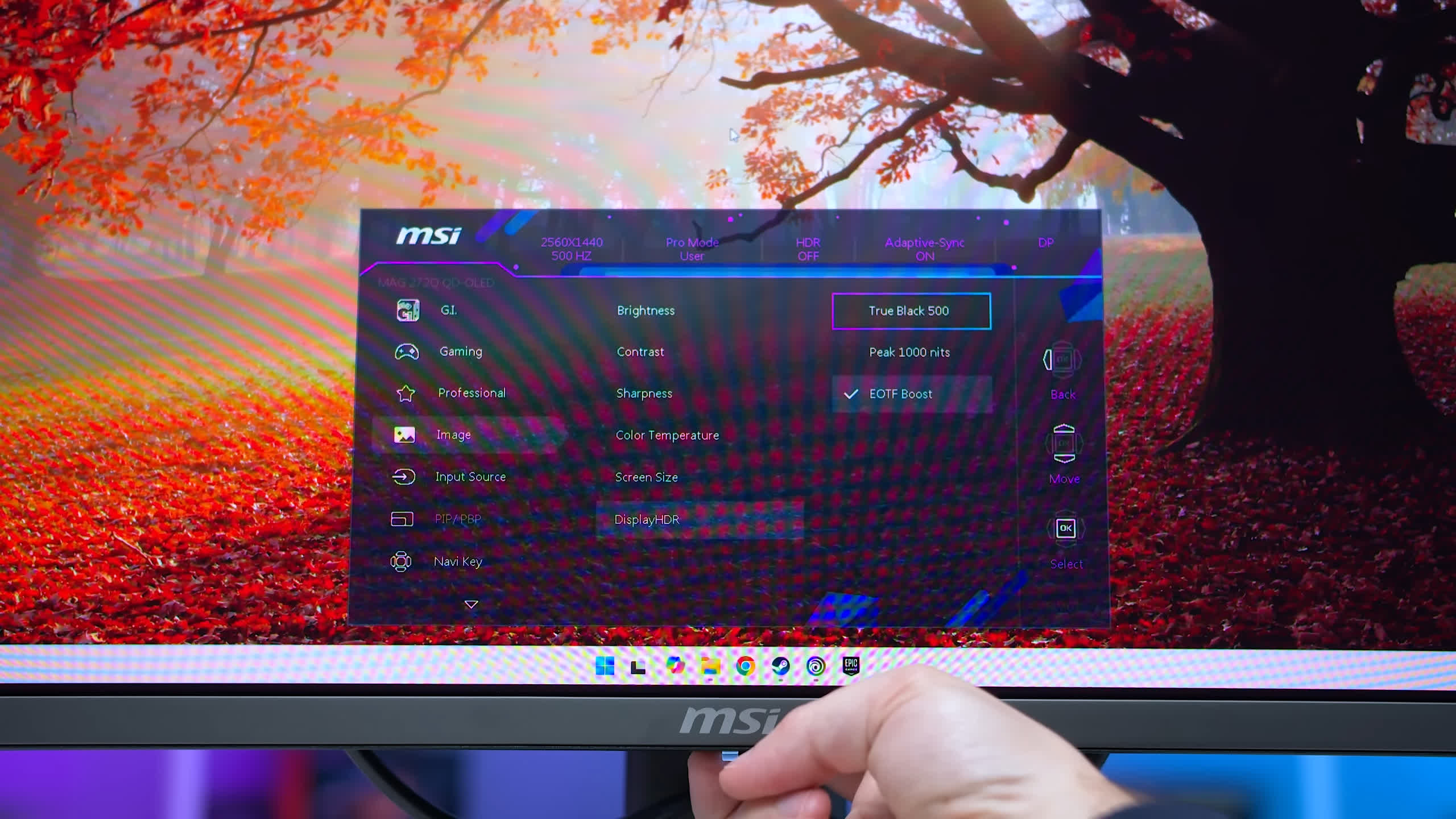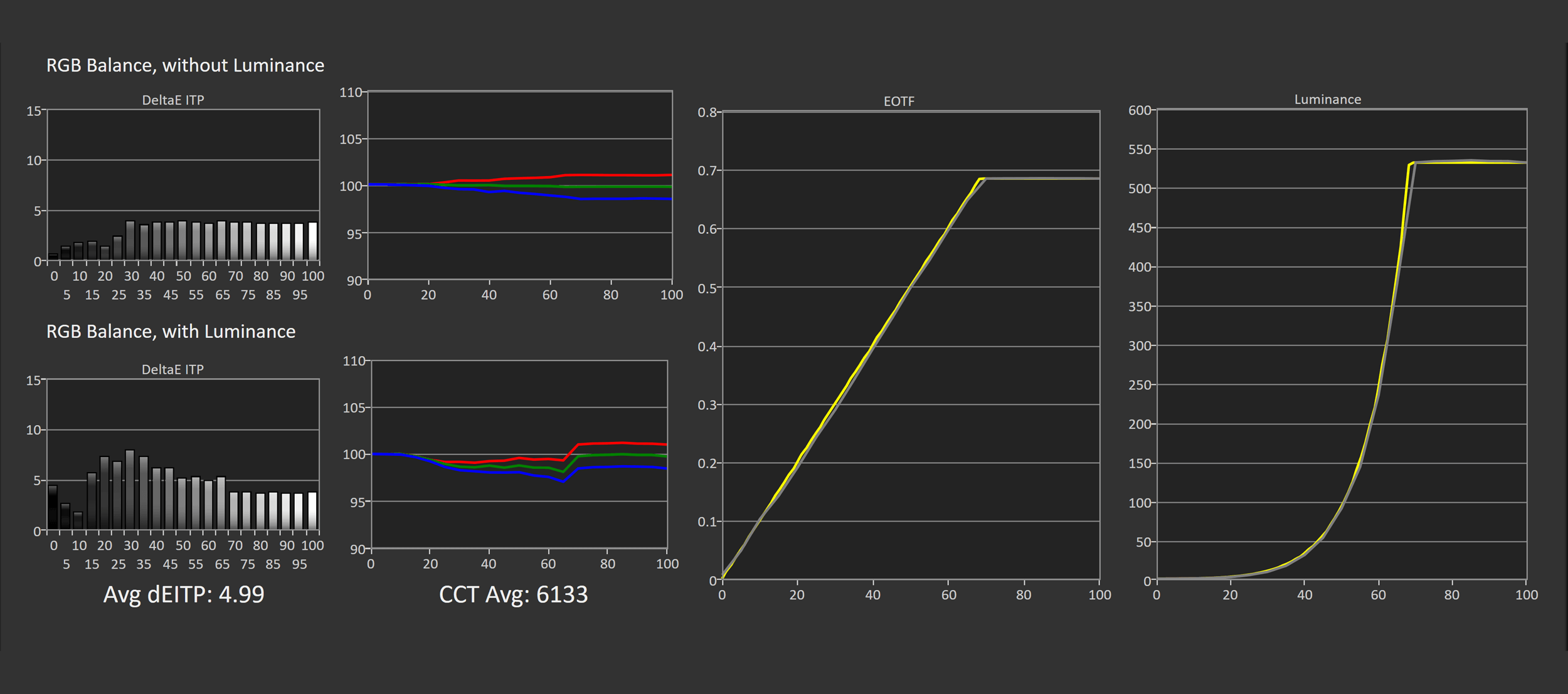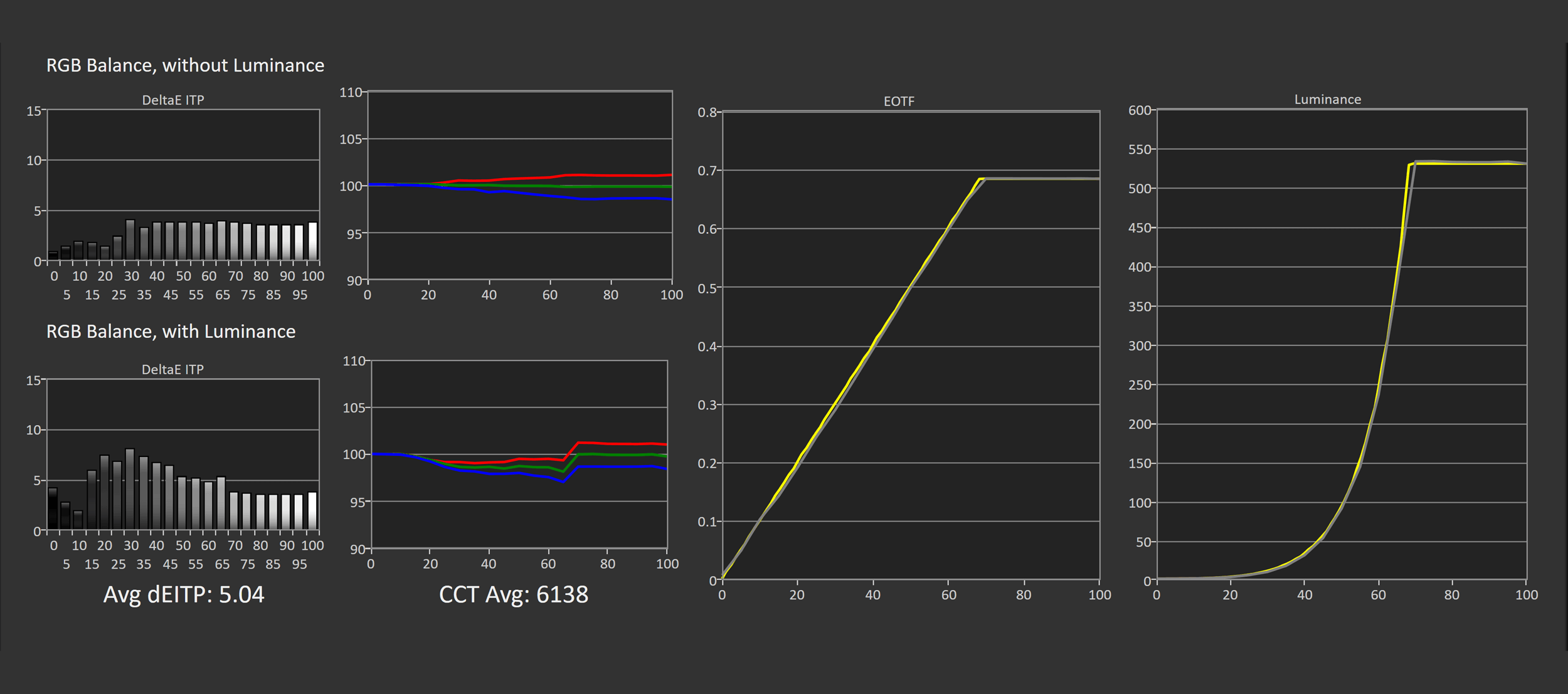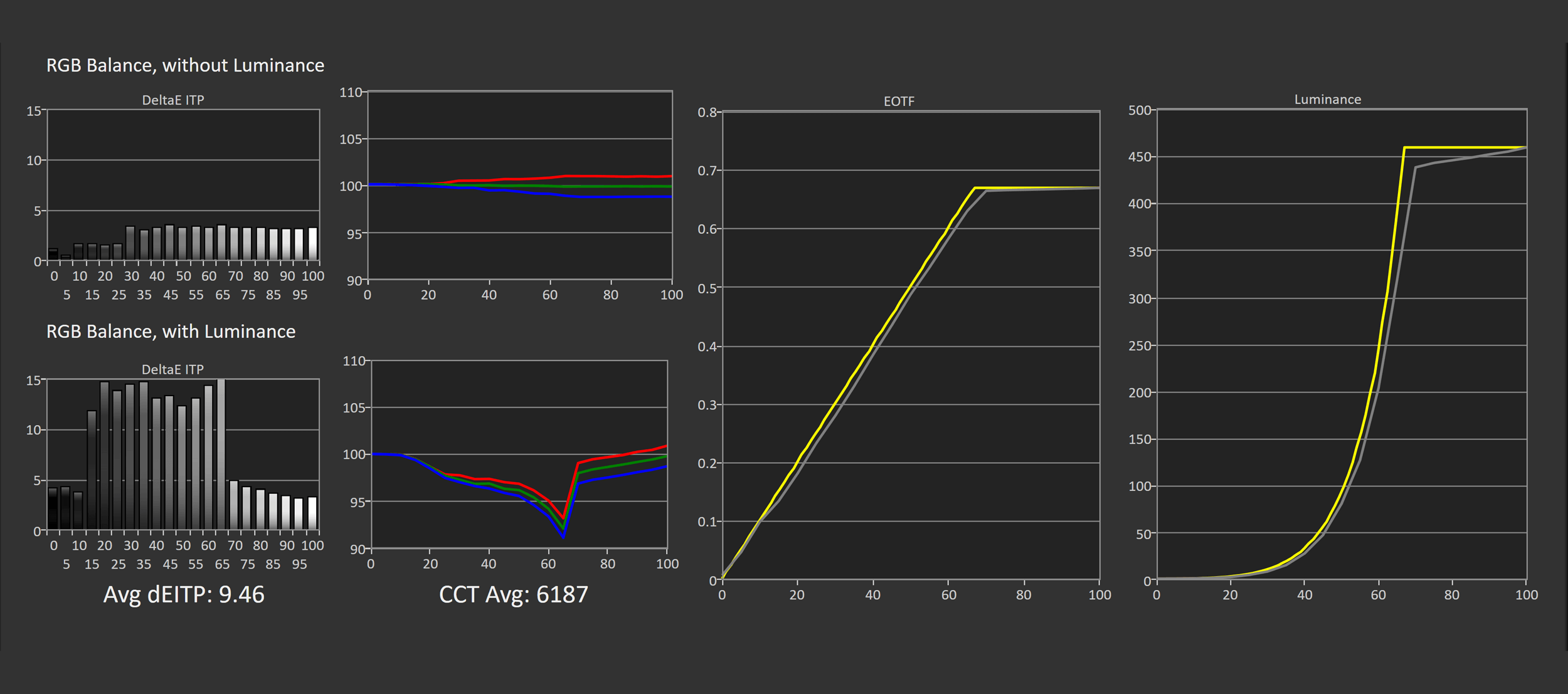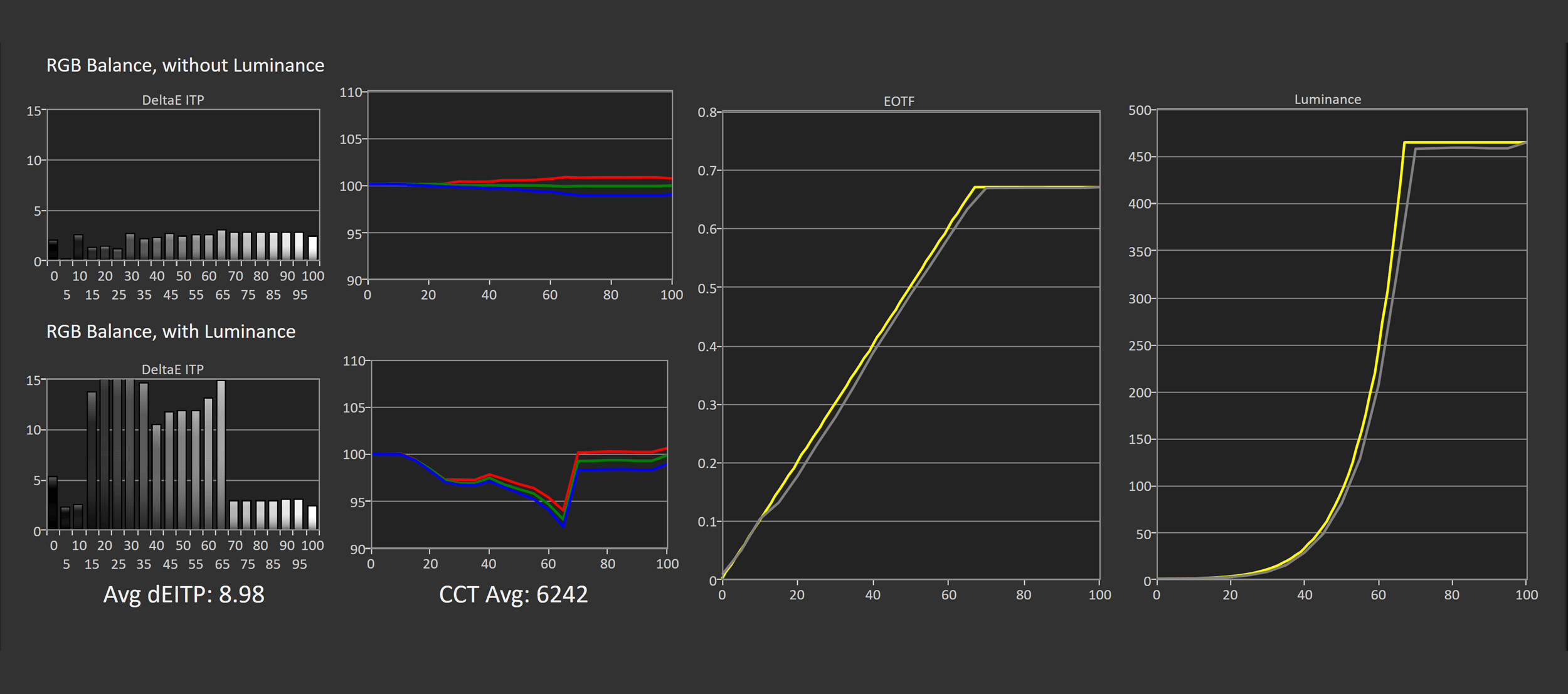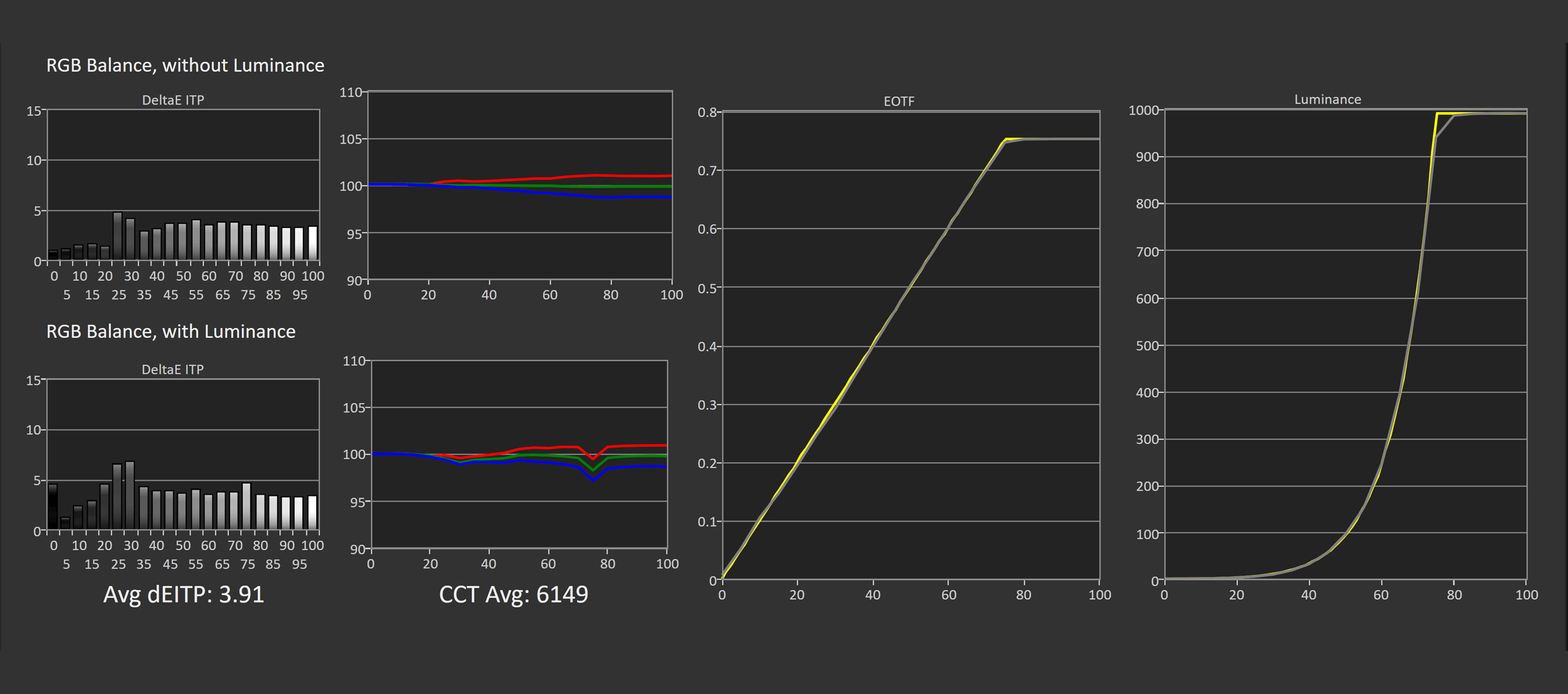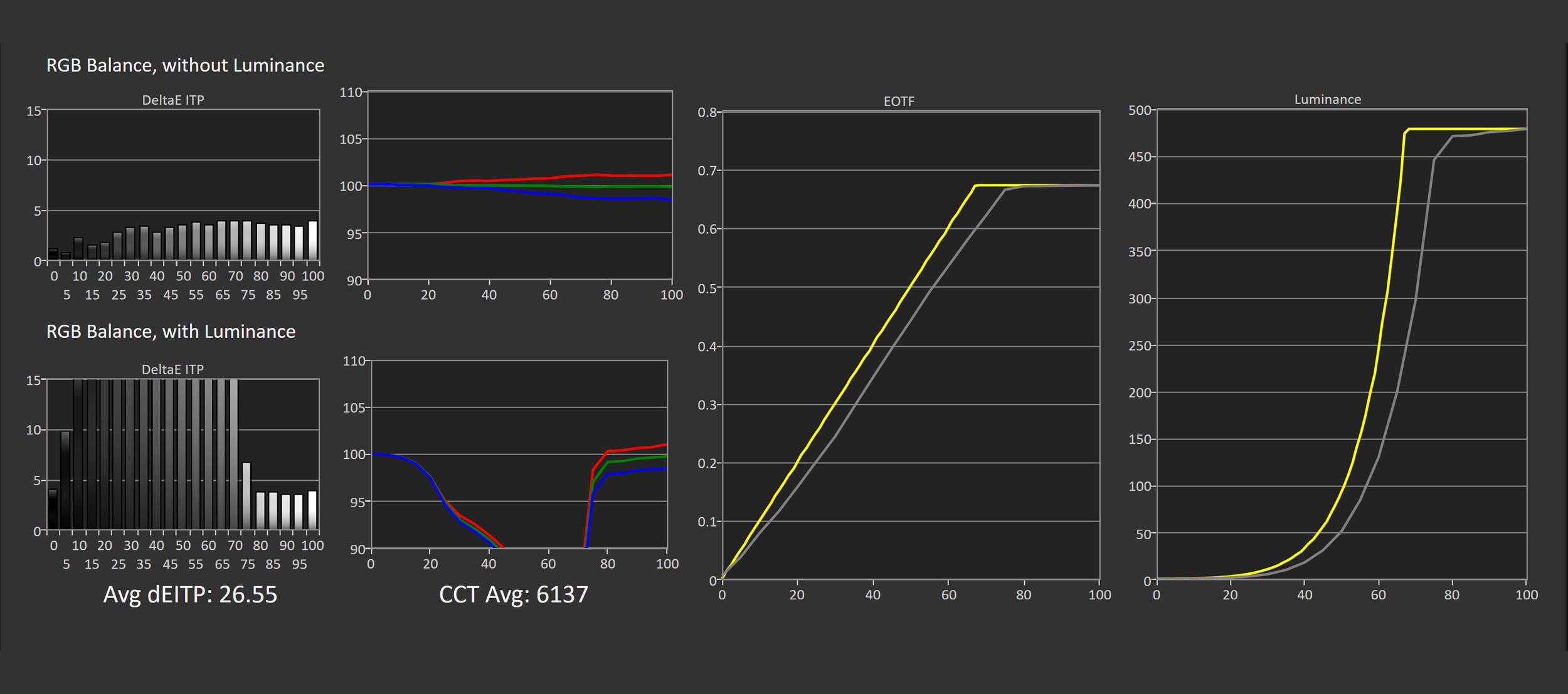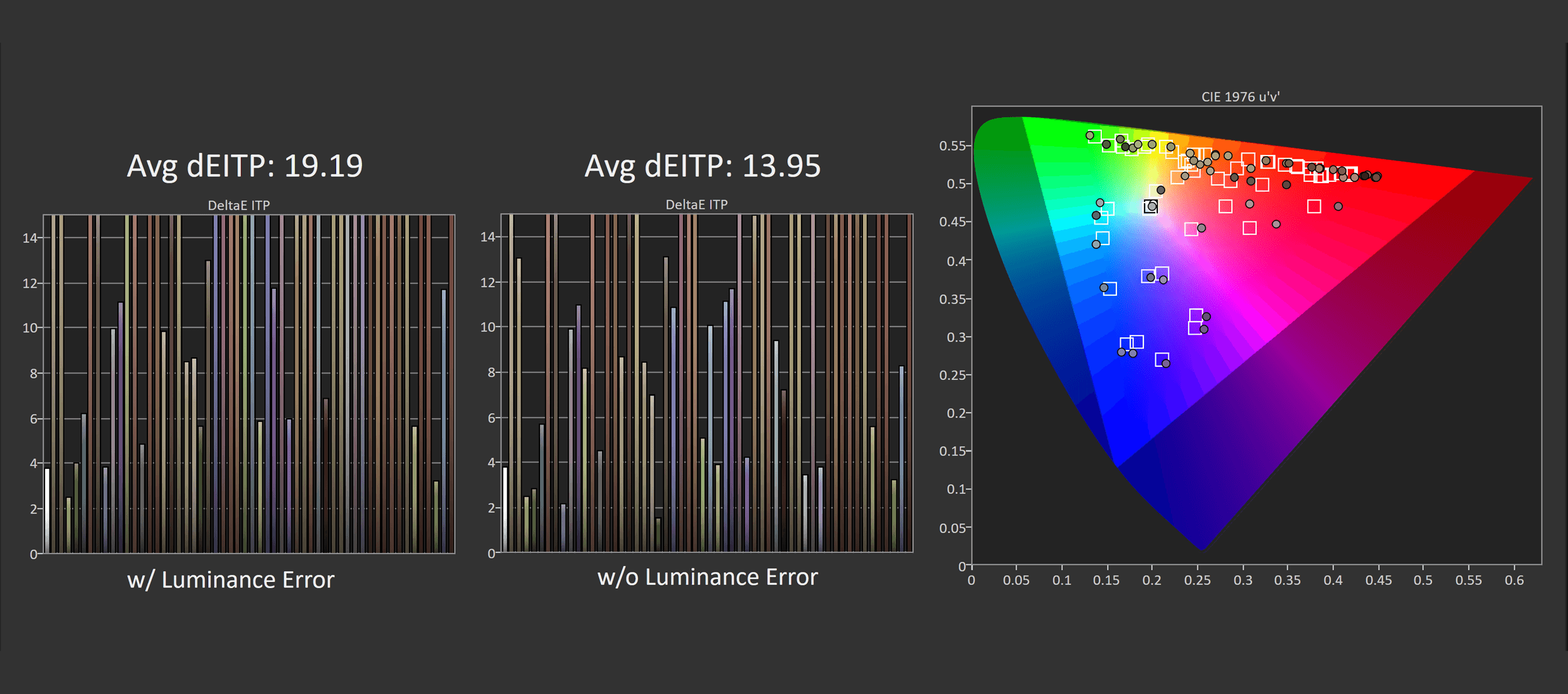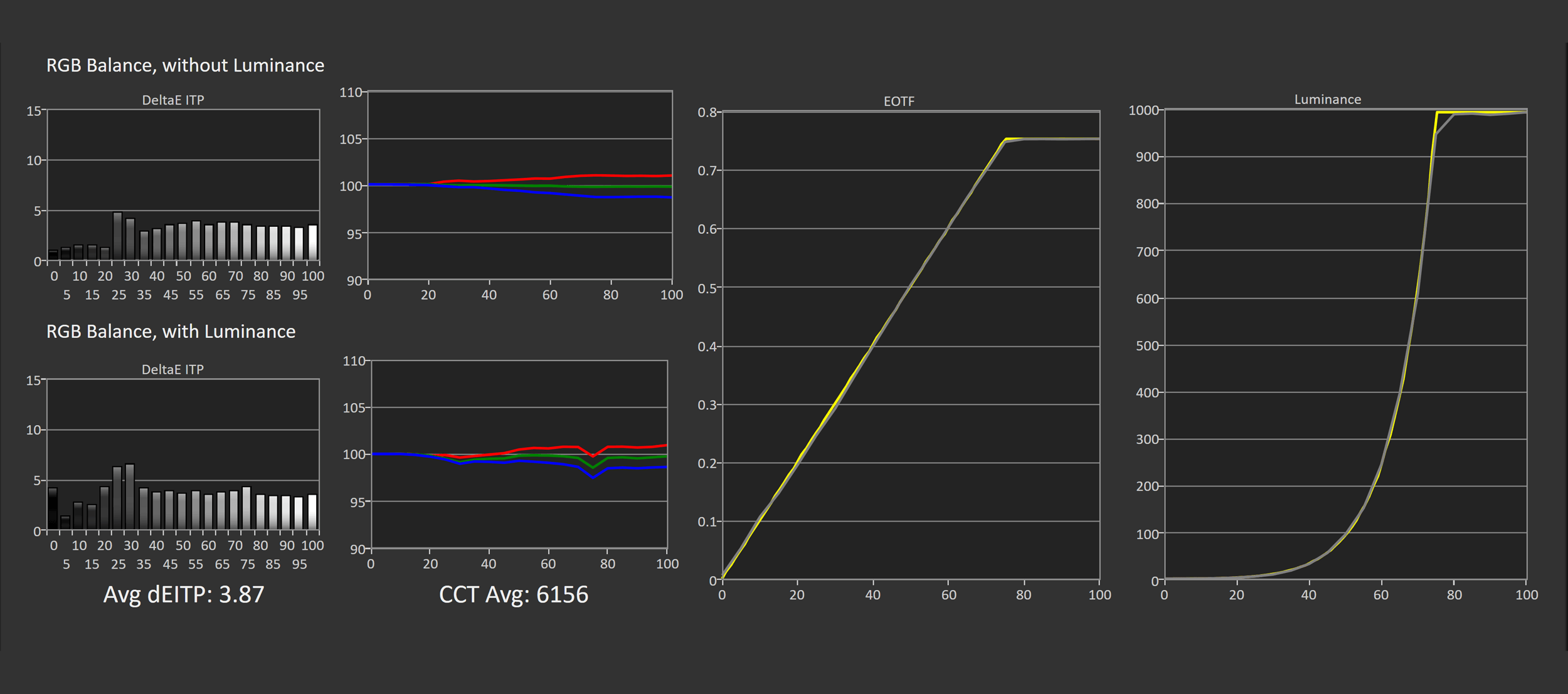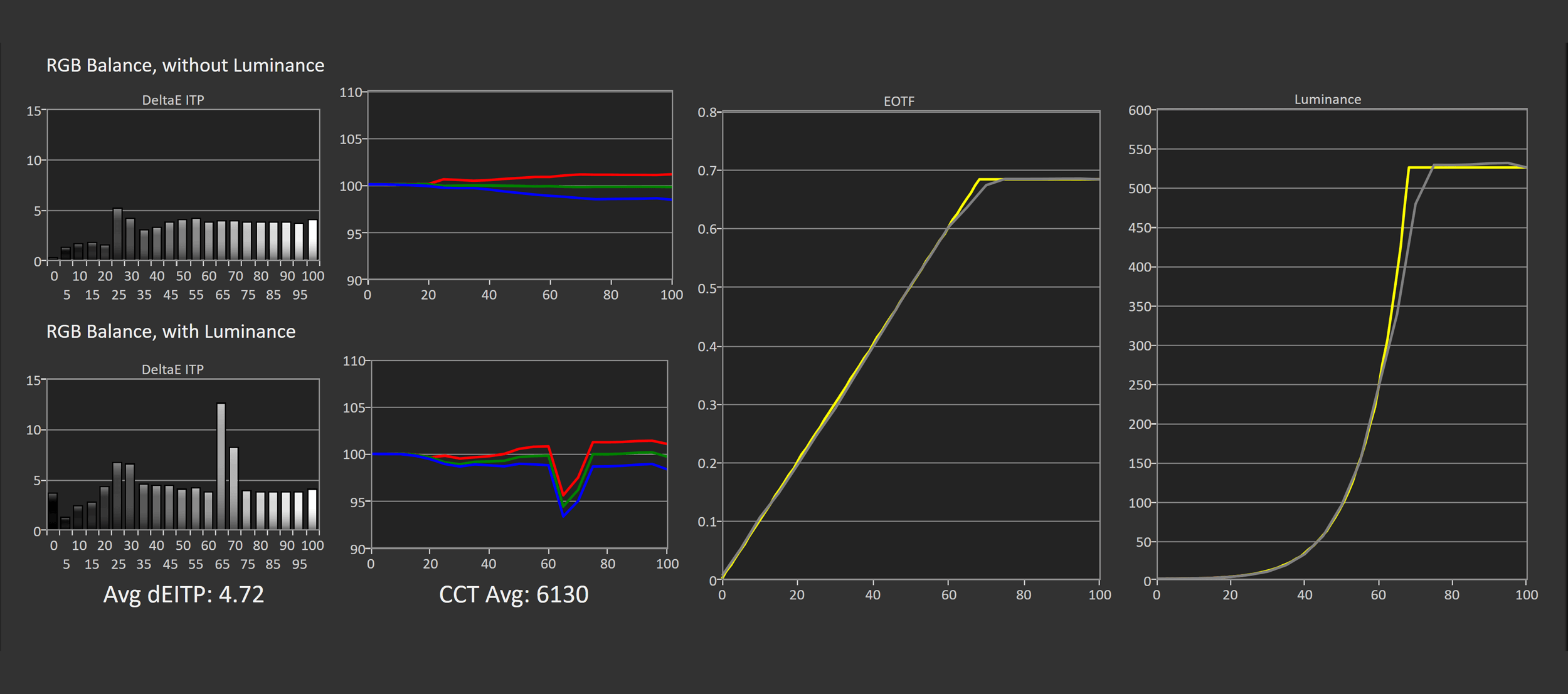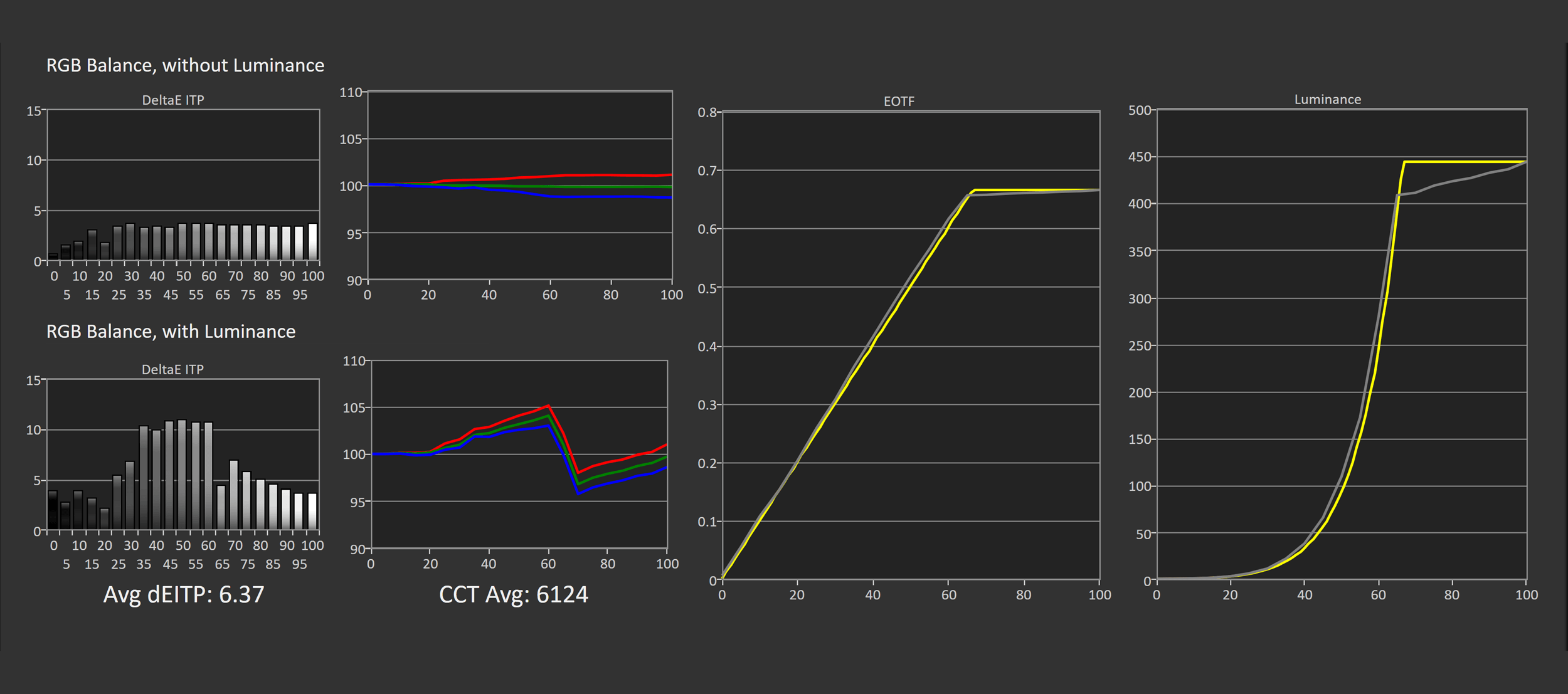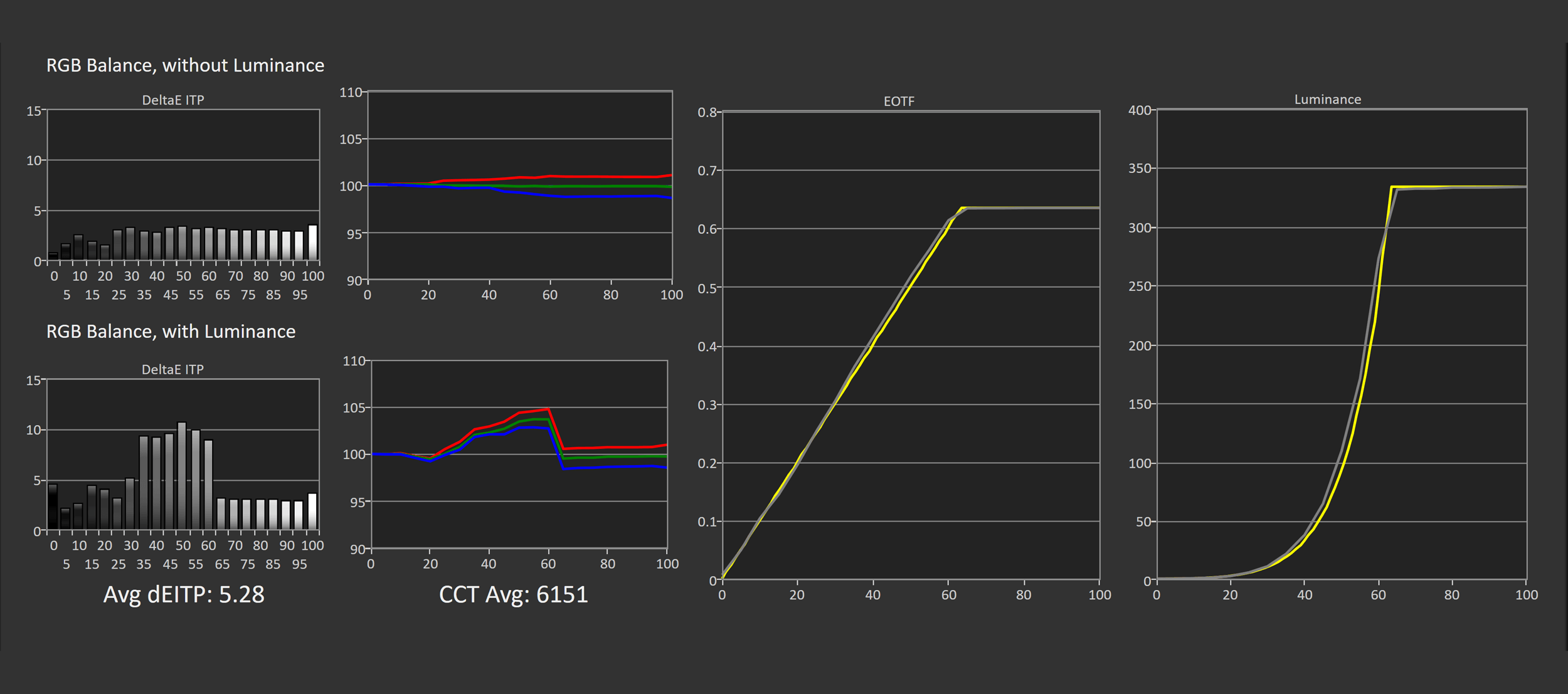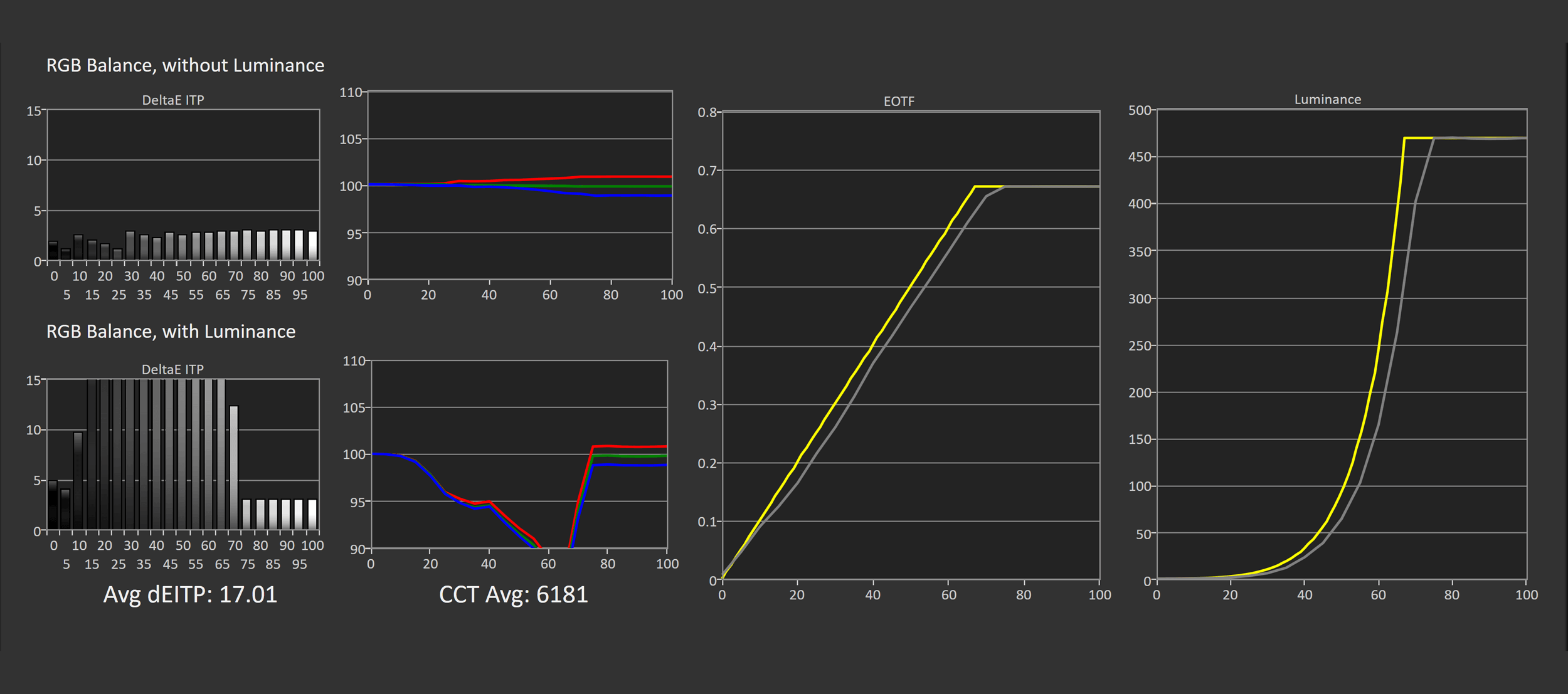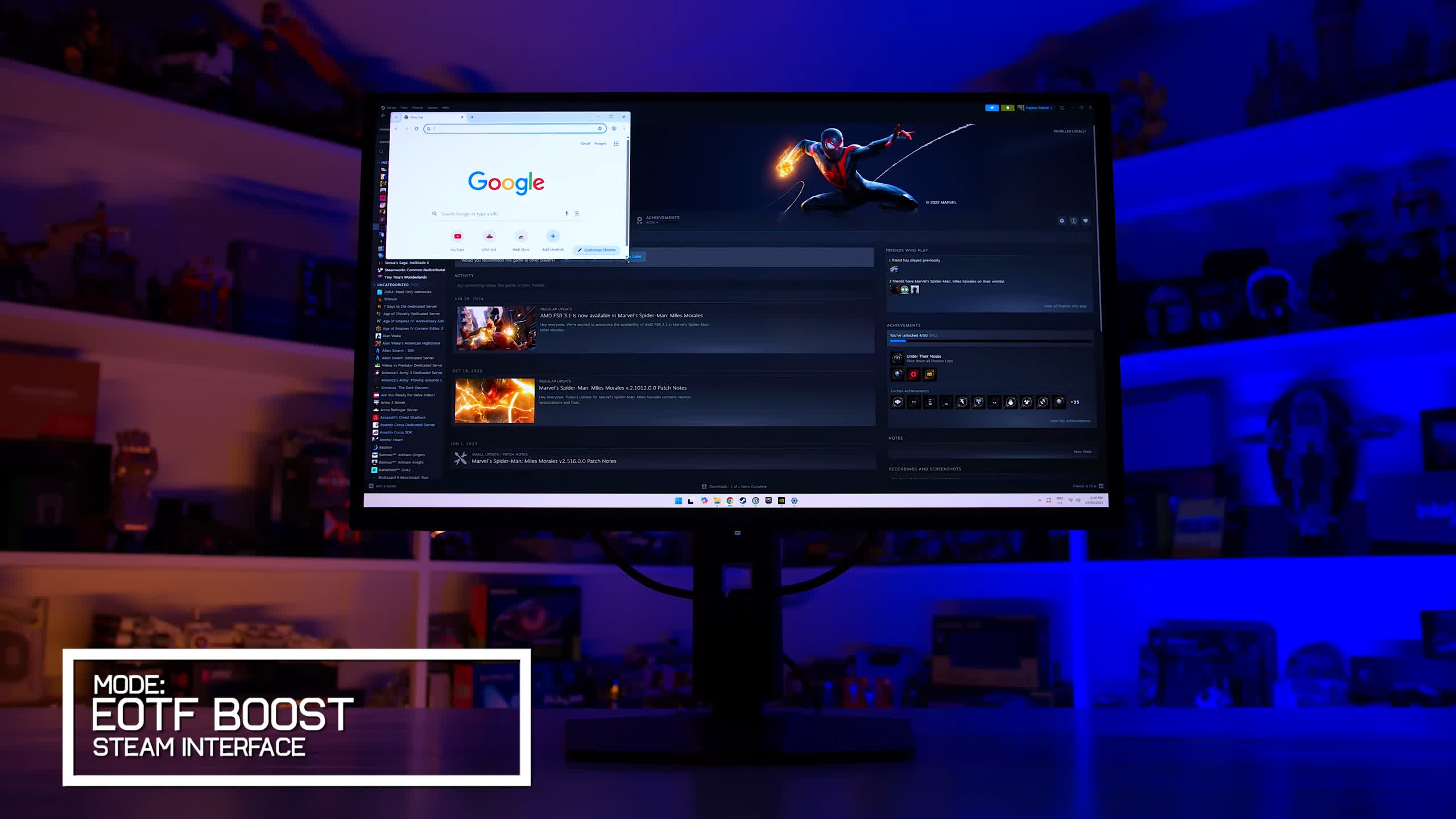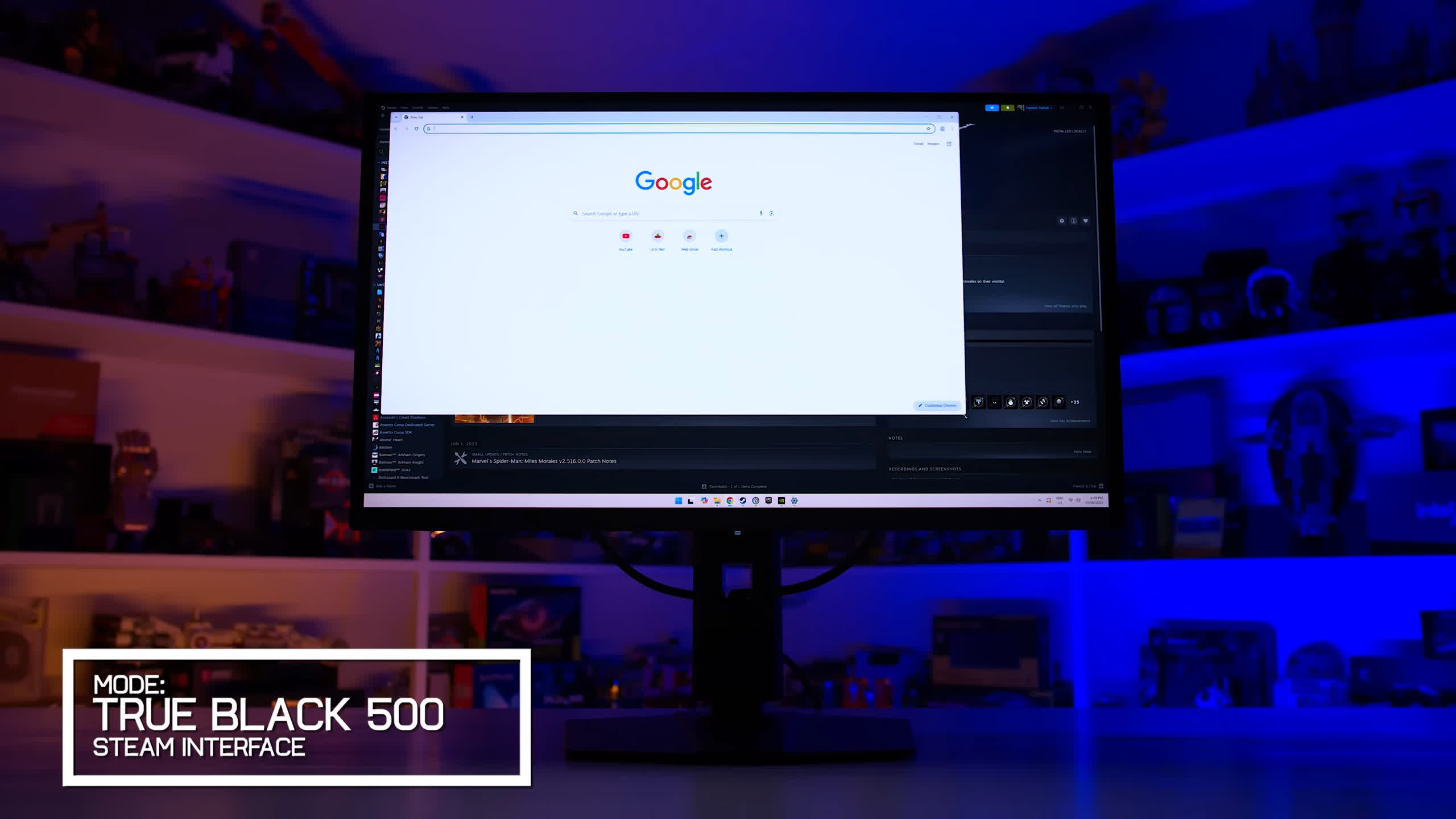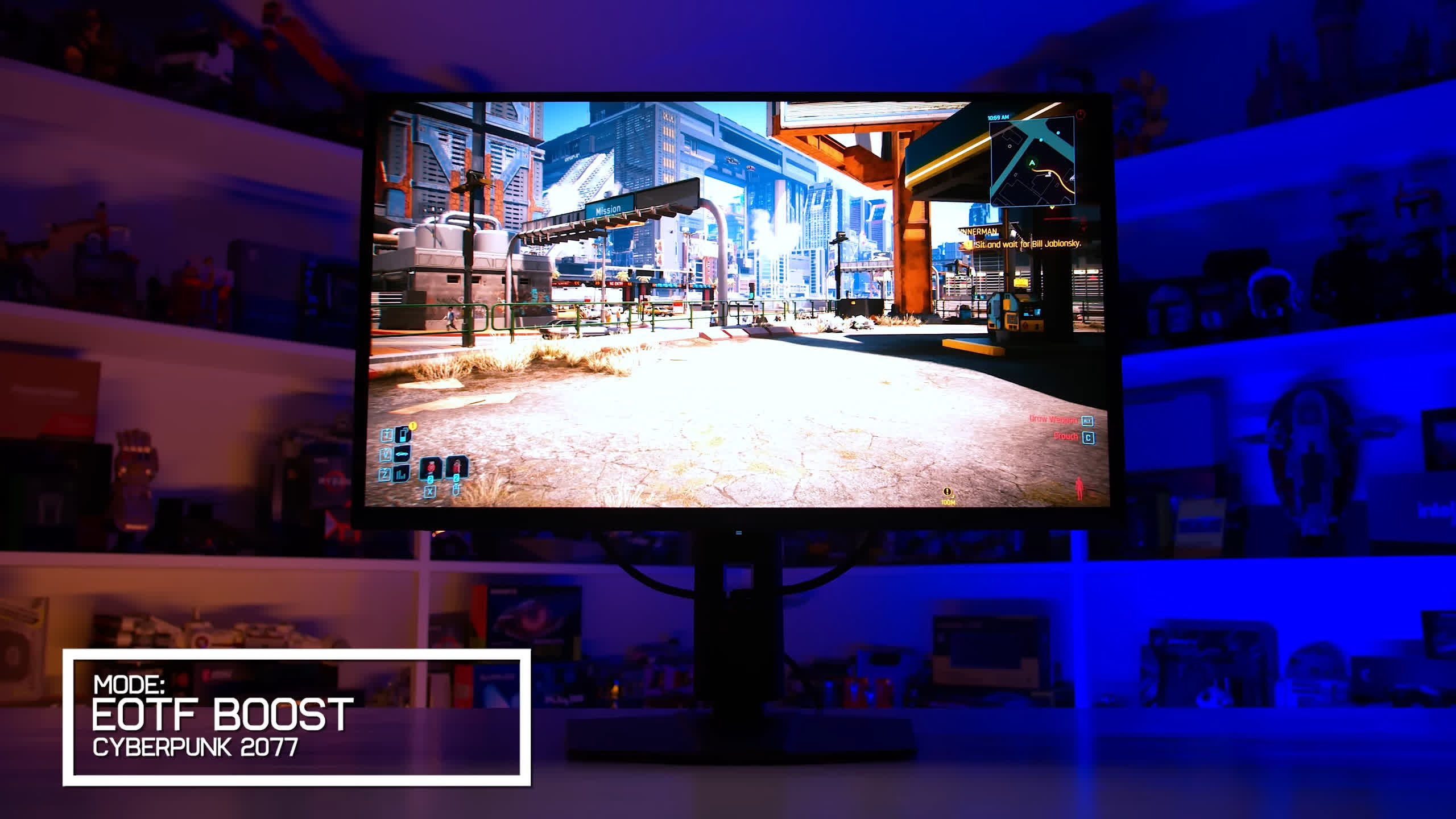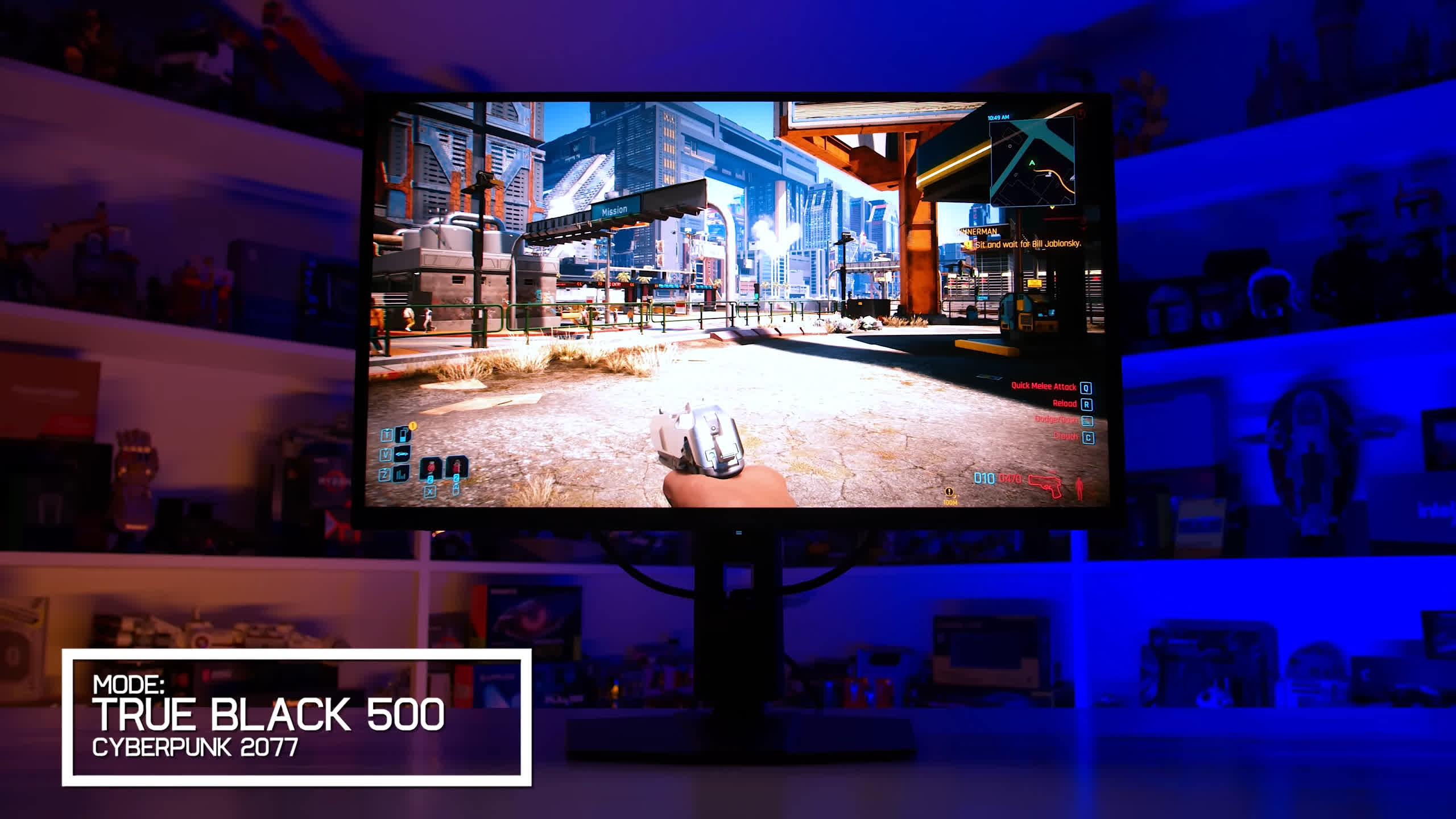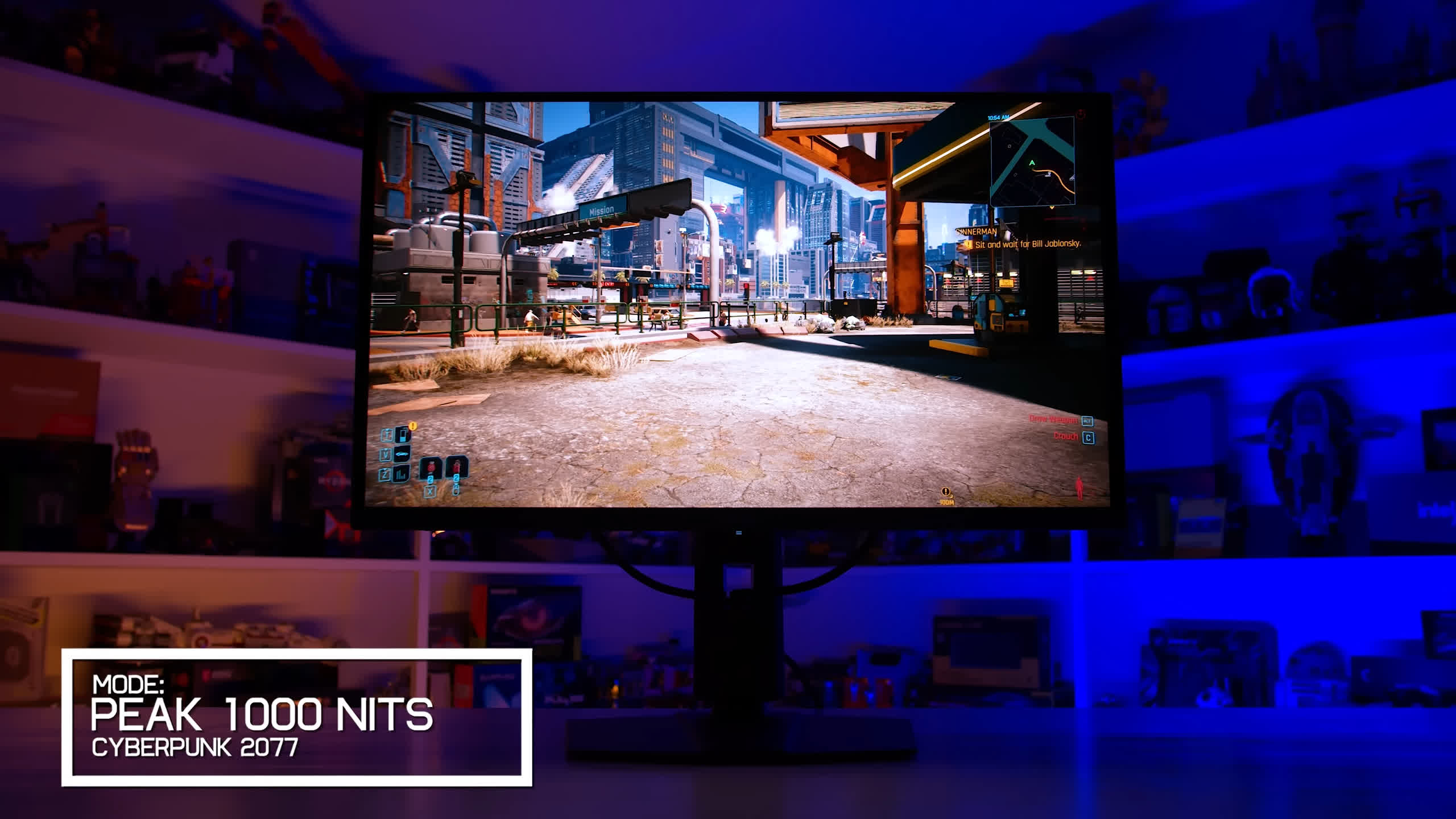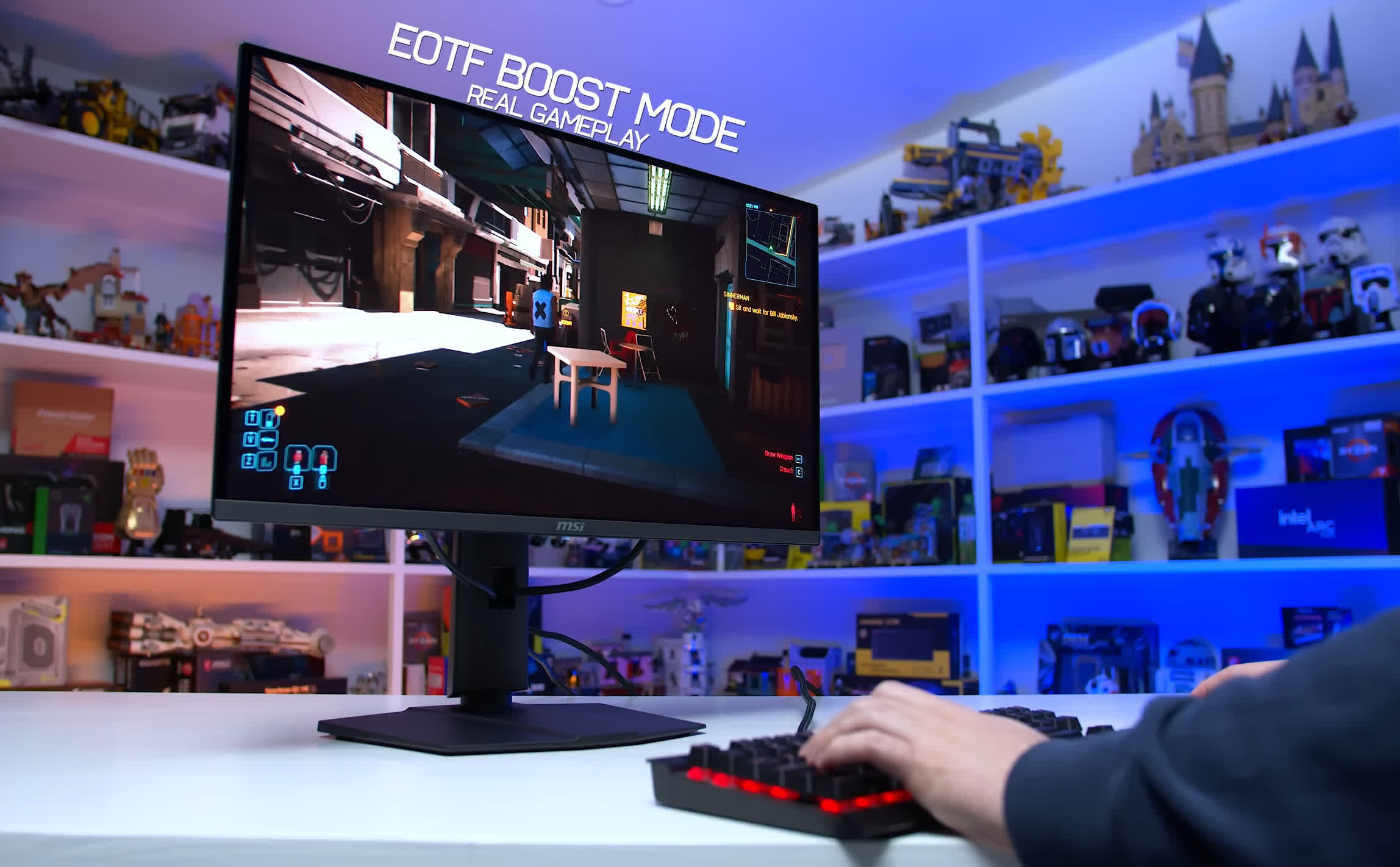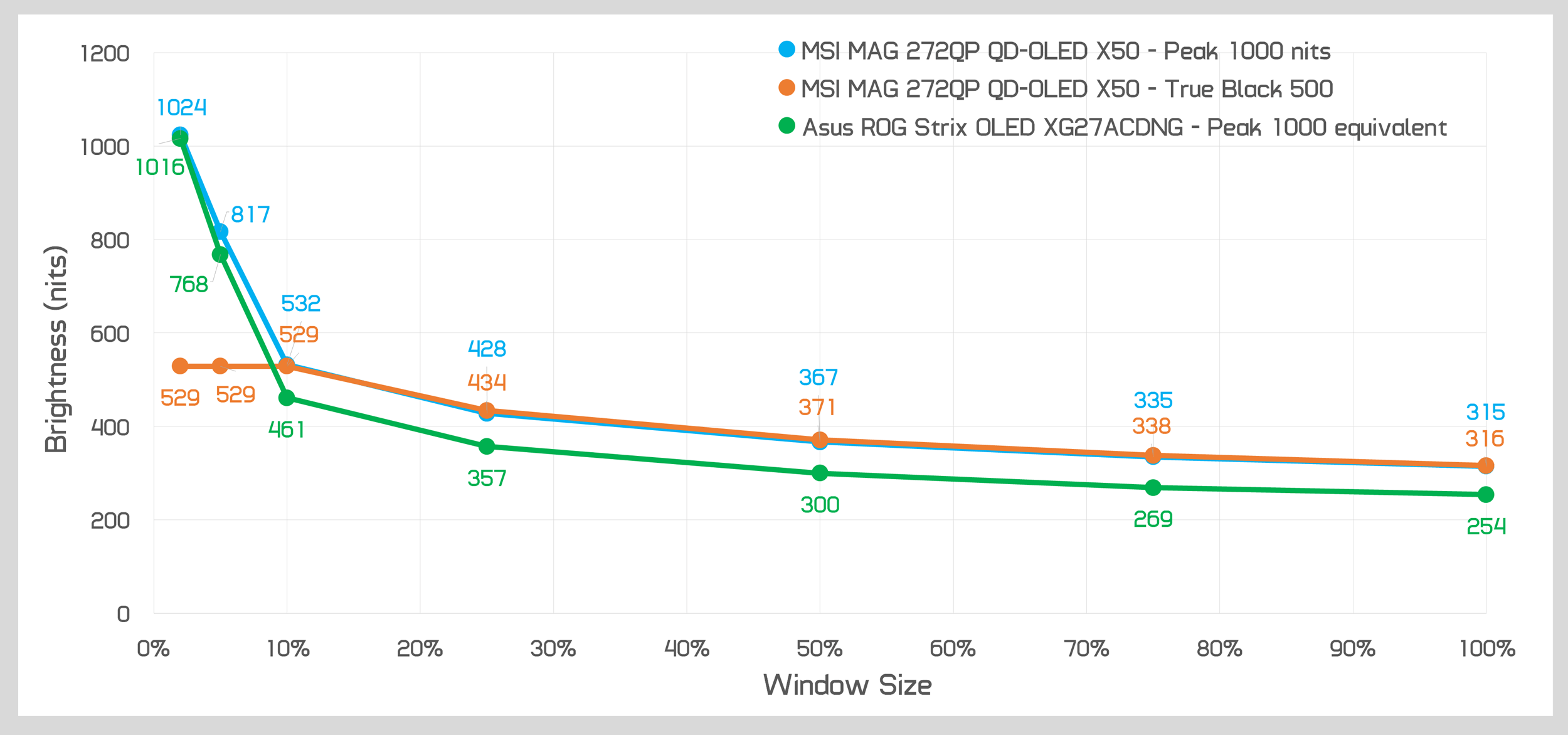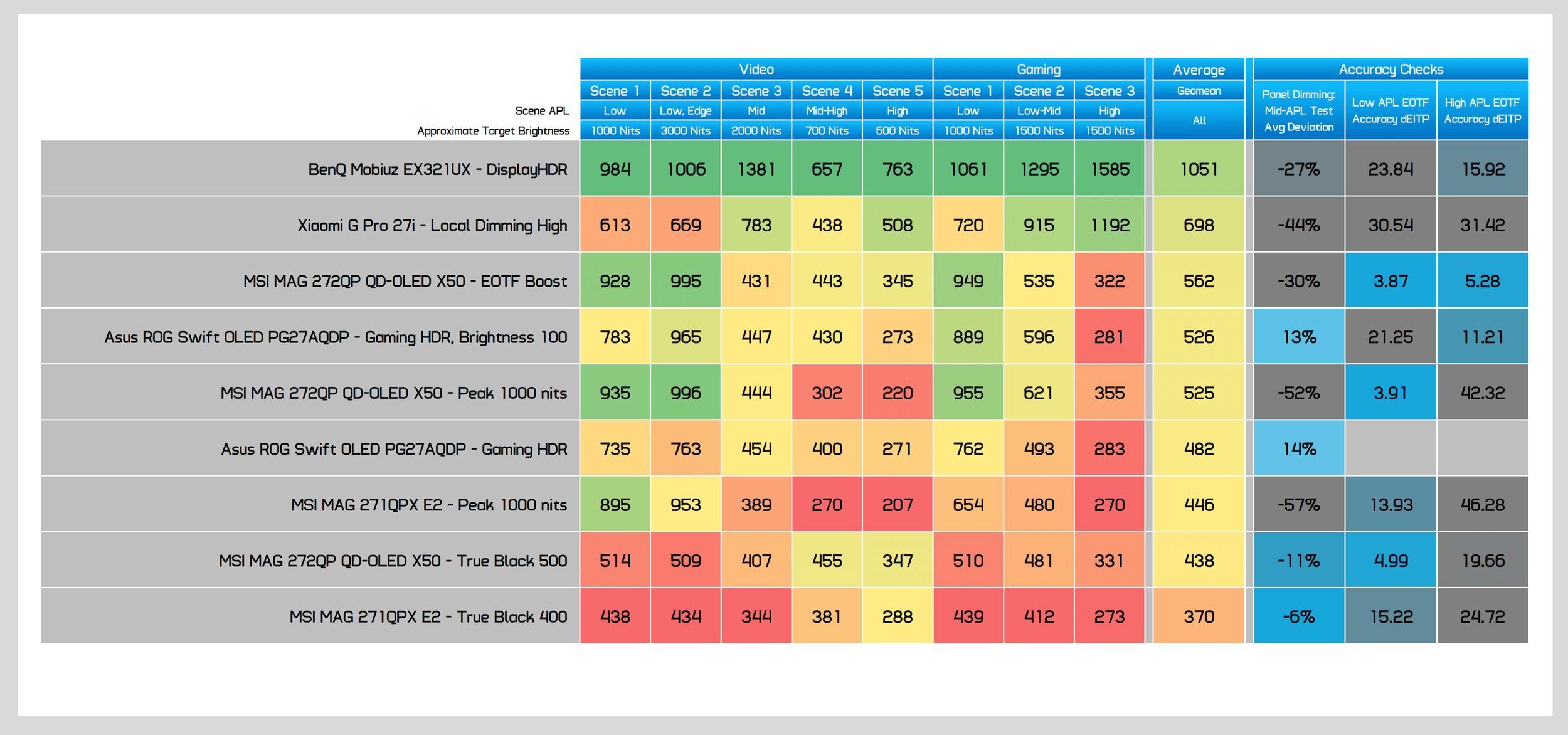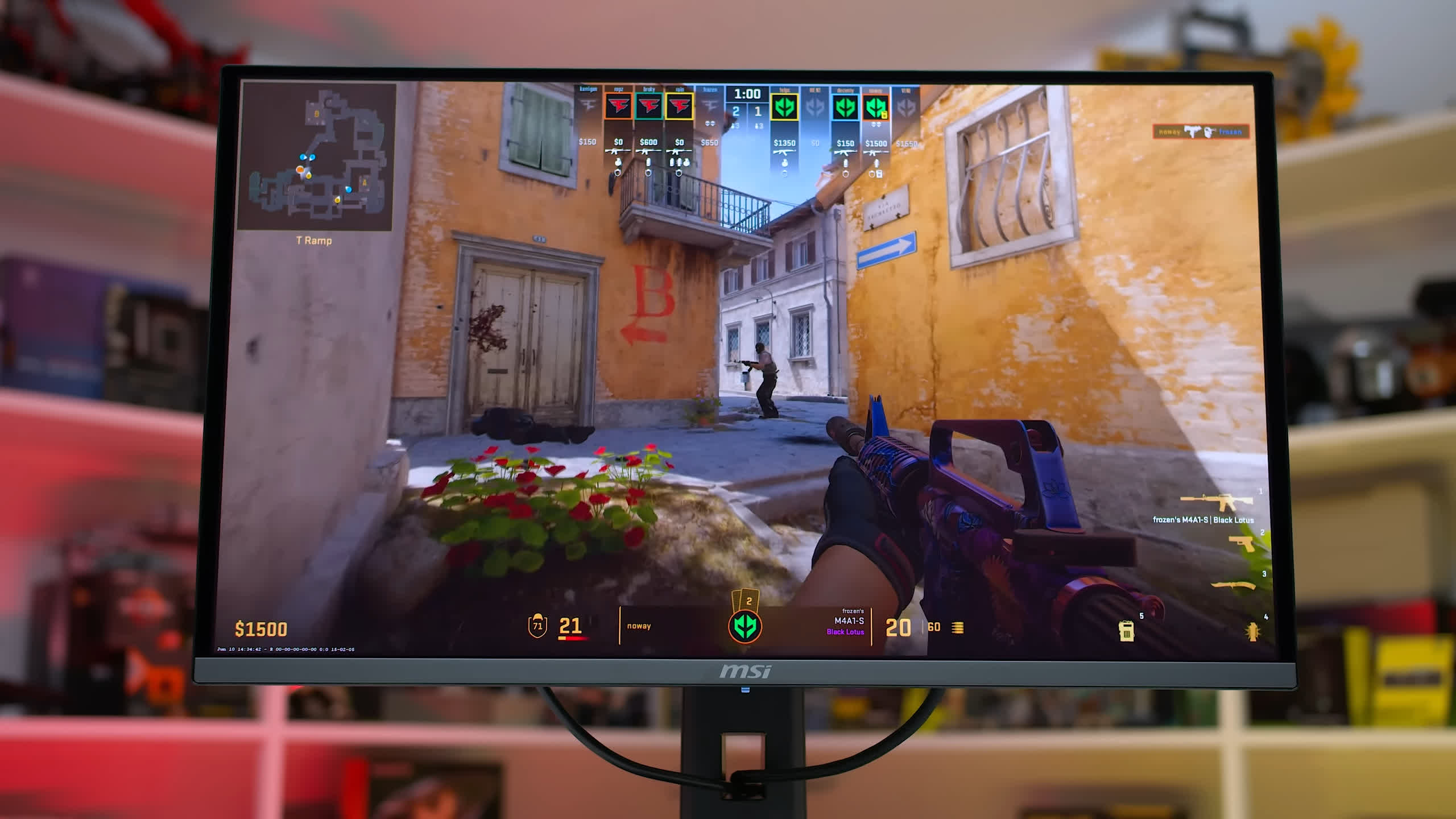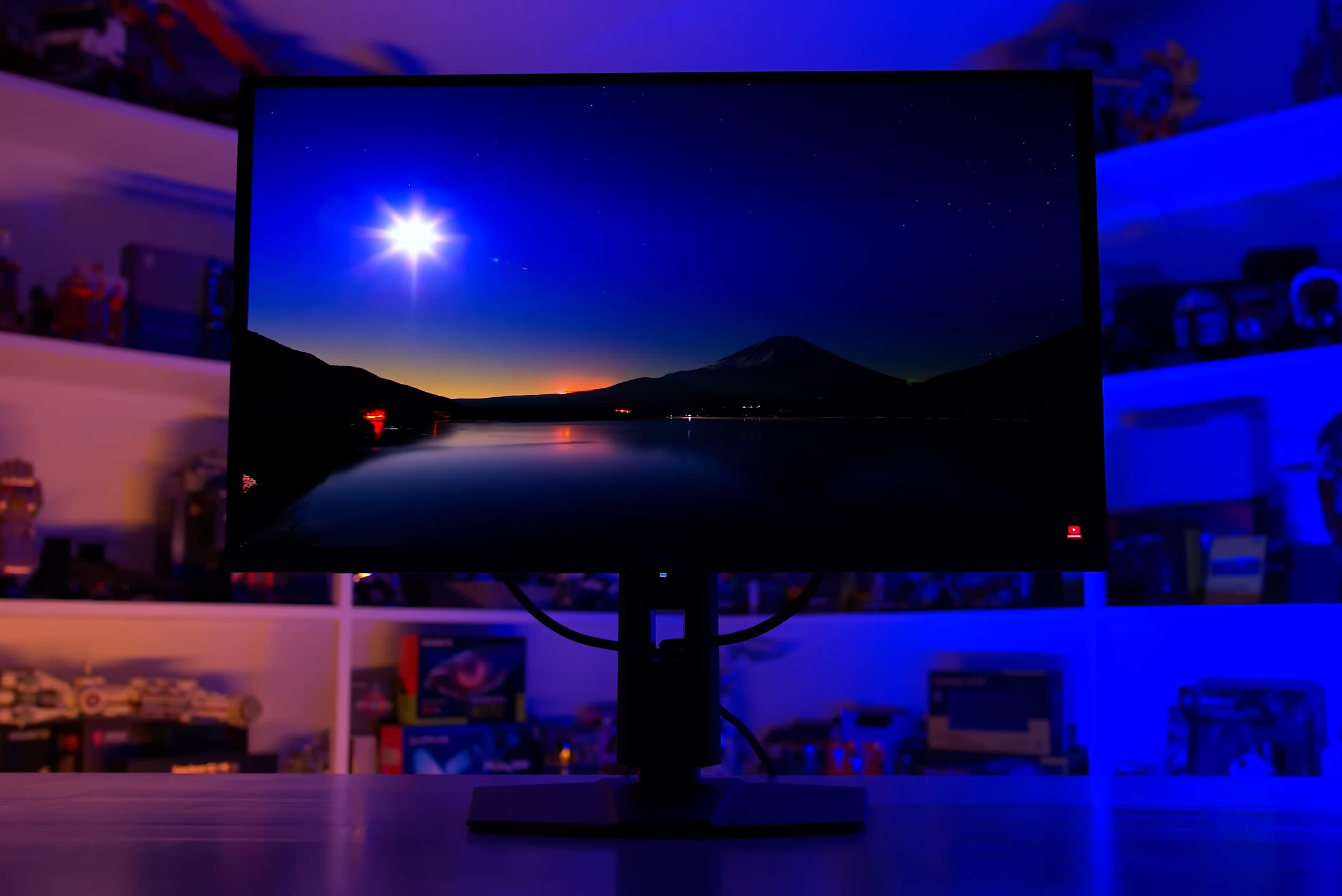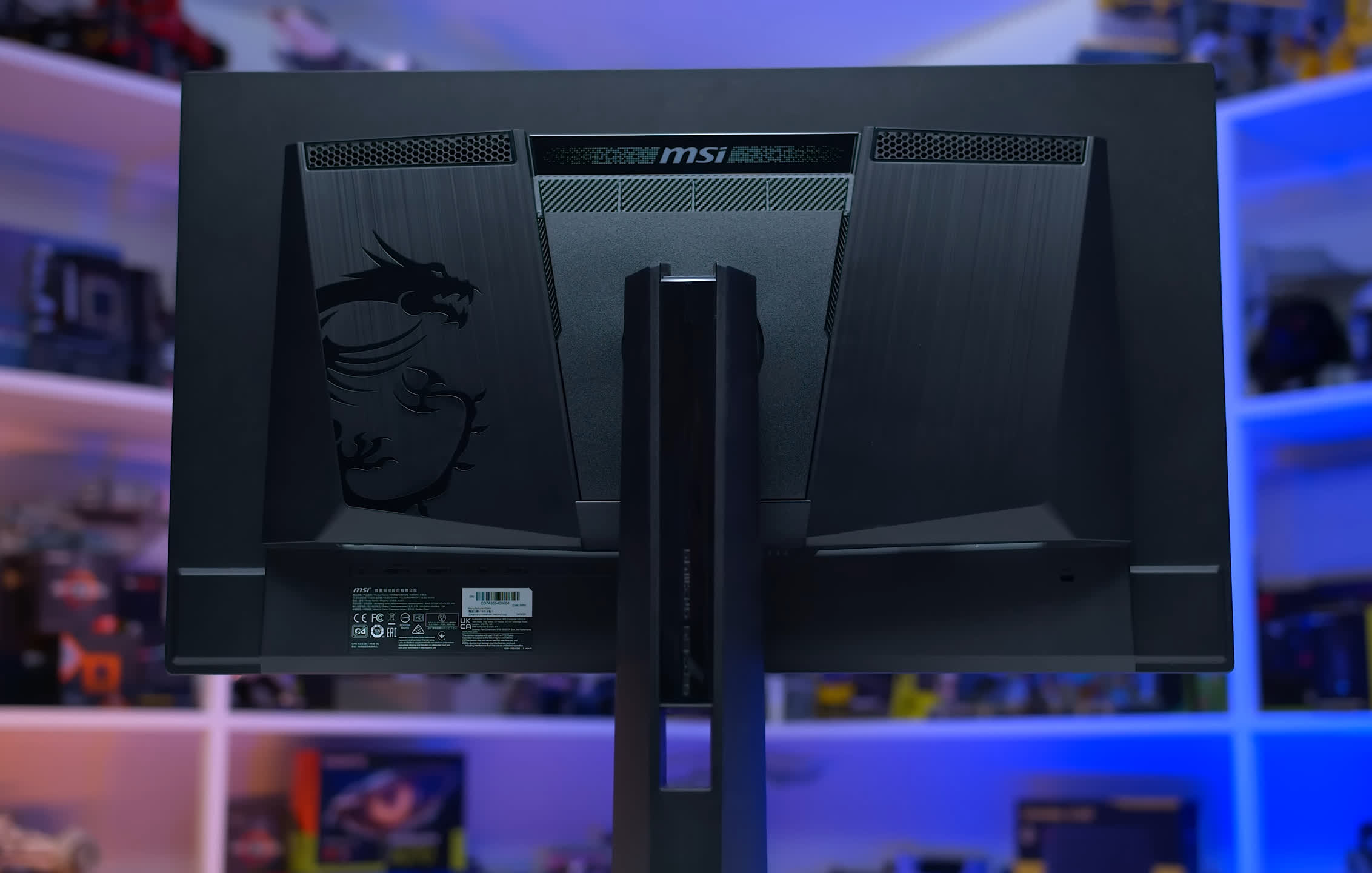MSI’s newest gaming monitor has a reputation that reads extra like a motherboard mannequin quantity: the MAG 272QP QD-OLED X50. It is a mouthful, positive, however the essential half is on the finish – “X50” – as a result of that is the primary QD-OLED panel to hit a blistering 500Hz.
At a look, it’d look like an easy spec bump over final yr’s 360Hz QD-OLEDs. However the X50 brings extra to the desk than simply uncooked pace. Samsung Show has cranked up the panel’s brightness sufficient to earn a VESA DisplayHDR True Black 500 certification, a step up from the True Black 400 customary utilized in earlier fashions.
To satisfy the True Black 500 specification, the display screen should obtain 300 nits in full-screen white and 500 nits in a ten% window – each larger than earlier fashions.
That is additionally the primary monitor we have examined with MSI’s new EOTF Increase perform, their newest try to handle QD-OLED panel dimming. Their first effort, which we examined earlier this yr, was restricted in effectiveness and solely labored underneath particular circumstances. MSI claims this up to date EOTF Increase is a broader and simpler resolution. We’ll see how that holds up in observe.
MSI is positioning the X50 as one of many extra inexpensive 500Hz displays, launching at $850. At Computex, most different distributors utilizing this panel had been focusing on a $900 worth level. If these figures maintain, MSI shall be coming into the market barely beneath that.
What is definite is that 500Hz QD-OLED displays will debut at a cheaper price than 480Hz WOLED displays just like the Asus PG27AQDP and LG 27GX790A, each of which carry a $1,000 MSRP. Nevertheless, though we’re reviewing a closing retail unit in the present day, MSI has informed us that the X50 will not be obtainable till late July in most areas.
Design and Ports
The design of the 272QP X50 is equivalent to different latest MSI gaming displays. The entrance showcases the show with its typical shiny end and a grey chin that includes the MSI emblem. Across the again, there’s MSI’s signature central field that homes all key elements, with the skinny OLED panel extending outward.
This field is made out of customary black plastic and consists of a wide range of textures and vents. It is a considerably gamer-centric design, though there is no RGB lighting. The construct high quality is first rate however not fairly on the extent of latest high-end Alienware fashions.
The stand includes a flat, sq. base we have seen for a number of years. It provides peak, tilt, swivel, and pivot changes and feels very sturdy, one thing we admire. The utmost peak is common.
For connectivity, the monitor consists of one DisplayPort 1.4 with DSC, two HDMI 2.1 (48Gbps) ports with DSC, and a USB-C port that helps DisplayPort Alt Mode and offers 15W of energy supply. There’s additionally a 3.5mm audio output.
Nevertheless, there is no USB hub or KVM swap, which is stunning given that almost all different MSI displays embrace these options. That mentioned, MSI plans to launch a second variant, the MPG 271QR X50, a couple of months later. That mannequin will improve DisplayPort to the two.1 UHBR20 spec, add a USB hub, and enhance USB-C energy supply to 98W.
As issues stand, except a USB hub or KVM swap is important, we imagine the present port choice is ample. The usage of DisplayPort 1.4 with DSC is just not a disadvantage; in sensible phrases, there is no noticeable distinction in usability in comparison with DisplayPort 2.1.
There are not any performance limitations with DP 1.4 on this monitor, as it might probably ship 10-bit 500Hz output over each DisplayPort and HDMI (DSC is required in each instances). For console avid gamers, the show helps 1080p and 1440p enter as much as 120Hz with HDMI VRR. Nevertheless, there is no such thing as a 4K downscaling mode.
The on-screen show (OSD) is managed through a directional toggle situated behind the MSI emblem. It consists of the standard MSI function set, similar to a broad vary of colour controls, a number of image modes, and gaming instruments like a crosshair, sniper mode, refresh price counter, and black stabilizer.
MSI additionally provides probably the most customizable OLED care settings obtainable. Customers can allow or disable options like static display screen detection and taskbar detection, and fine-tune how aggressively they function. Though there are not any USB ports on the monitor, firmware updates are nonetheless supported over DisplayPort.
Display screen Coating, Subpixel Format and Burn In
Whereas the 272QP X50 makes use of a brand new 500Hz QD-OLED panel from Samsung Show, the core {hardware} is identical as earlier 27-inch 1440p QD-OLED panels that had been obtainable at 360Hz and 240Hz. There are not any adjustments to the subpixel construction, panel composition, or display screen coating. As such, that is nonetheless thought-about a third-generation panel.
Because the subpixel structure stays unchanged – nonetheless utilizing the revised triangle RGB structure – textual content readability is identical as different 1440p QD-OLEDs. In comparison with LCDs on the identical measurement and backbone, QD-OLEDs are typically weaker in textual content rendering as a consequence of pink or inexperienced fringing across the prime and backside of characters.
Whether or not that is noticeable is determined by your sensitivity to such artifacts. Textual content readability is on par with 480Hz WOLED panels utilizing an RGWB structure, although the artifacts differ. In comparison with older 240Hz WOLED panels with an RWBG structure, QD-OLED has a bonus in textual content high quality.
This QD-OLED panel includes a shiny end, which is a double-edged sword. On the plus aspect, it provides higher sharpness and readability than matte coatings, with out grain or diffusion that may cut back perceived distinction. Nevertheless, the downsides embrace mirror-like reflections, although they’re comparatively nicely managed right here, and diminished black ranges in well-lit environments.
Ambient gentle can activate the quantum dot layer, making blacks seem grey. This undermines considered one of OLED’s core strengths however may be mitigated by utilizing the monitor in a dim room with lighting behind the display screen. Whether or not a shiny QD-OLED is appropriate is determined by your surroundings and preferences.
OLED panels of all varieties are additionally vulnerable to everlasting burn-in. This typically is not a problem whereas gaming or watching video, however extended show of static content material may cause it over time. That makes OLED much less very best for productiveness duties involving static desktop home windows all through the day.
You possibly can discuss with our ongoing OLED burn-in sequence for real-world information on how this impacts long-term use. Occasional static use, like internet searching between gaming periods, is ok. We simply would not suggest OLED for prolonged work hours. MSI consists of a regular 3-year burn-in guarantee.
Response Time Efficiency
Response time efficiency is superb on this MSI QD-OLED monitor, as it’s on most OLEDs we have examined. OLED know-how provides extraordinarily quick response occasions, round 0.3ms throughout all refresh charges, and this efficiency is constant even at decrease refresh charges. That makes OLED very best for avid gamers utilizing variable refresh price (VRR), since there is no want to modify between overdrive modes.
There’s successfully no distinction in response time efficiency between this QD-OLED and different OLED displays, together with WOLED fashions. OLEDs considerably outperform even the quickest LCDs, whether or not we’re measuring best-case or common response occasions throughout the refresh vary. Along with pace, OLEDs additionally keep away from the overshoot artifacts frequent in some LCD panels.
When analyzing cumulative deviation, OLEDs come a lot nearer to very best response habits and sometimes outperform LCDs by an order of magnitude on this metric. In observe this results in round a 1.5x benefit in readability at a given refresh price, so 500Hz QD-OLEDs provide an identical expertise to 750Hz LCDs, which at the moment do not exist at this decision. In common utilization circumstances, particularly with options like adaptive sync and HDR enabled, this is among the quickest, smoothest and clearest displays you may get.
It is troublesome to definitively say whether or not you “want” a 500Hz show. We imagine the strongest case for this type of panel is in aggressive multiplayer gaming, the place larger body charges are extra frequent and the place elevated movement readability and decrease enter lag make a noticeable influence.
A key level to grasp when contemplating OLED for movement efficiency is that movement readability is instantly tied to refresh price. On the identical refresh price, two OLED displays will carry out practically identically. Meaning the precise refresh price you are gaming at issues greater than the monitor’s most refresh functionality. As an example, if one OLED monitor has a 500Hz ceiling and one other tops out at 240Hz, however each are working a recreation at 120 FPS with a 120Hz refresh price, the visible expertise would be the identical.
The place larger refresh price OLEDs turn out to be of profit is whenever you use the very best refresh price capabilities. Operating an OLED at 500Hz produces a clearer picture than at 240Hz, with higher smoothness and responsiveness – that is the important thing profit this new MSI monitor brings in comparison with older QD-OLEDs that topped out at 360 or 240Hz. This has benefits when gaming at excessive body charges, for instance multiplayer video games or video games with body era enabled.
However a better refresh OLED solely has a bonus whenever you exceed the refresh price of a decrease refresh mannequin: on this instance, a 500Hz QD-OLED shall be higher than a 240Hz QD-OLED when gaming at anyplace between 241 and 500 FPS with variable refresh enabled. Something at or beneath 240 FPS, there shall be no distinction, so preserve this in thoughts when purchasing between OLEDs as a result of 500Hz instructions a hefty premium that you just would possibly in any other case not use.
It is troublesome to definitively say whether or not you “want” a 500Hz show. We imagine the strongest case for this type of panel is in aggressive multiplayer gaming, the place larger body charges are extra frequent and the place elevated movement readability and decrease enter lag make a noticeable influence.
Some would possibly argue that this degree of efficiency provides diminishing returns, however we discover it to be a big improve, even for customers who do not completely play fast-paced video games. Nevertheless, a soar from 240Hz to 500Hz is not as transformative as going from 60Hz to 120Hz.
One other key comparability is to this panel’s closest competitor: 480Hz WOLED. Whereas the 500Hz QD-OLED is technically 20Hz quicker, this benefit is generally advertising. In observe it is just about unattainable to note a readability distinction between 480Hz and 500Hz, and the enter lag benefit is negligible.
The one present know-how that may rival the movement readability of a 500Hz OLED is a 540Hz LCD with backlight strobing, such because the Asus PG248QP. It is truly loads nearer than I believed it might be, however in edge case situations particularly tremendous quick movement, a strobed LCD does ship superior readability.
With that mentioned, backlight strobing on one thing just like the PG248QP is extremely restrictive, you need to sacrifice variable refresh charges and HDR, you need to run your recreation at a locked body price that matches the refresh price for it to work correctly, and usually we solely see this efficiency from TN LCDs which produce other points like viewing angles. The MSI X50 provides you nice movement readability in a much wider vary of circumstances, making it an enormous winner.
Black Body Insertion, MPRT Mode
MSI has added a black body insertion mode to this monitor known as “MPRT,” nevertheless it features otherwise from Asus’s equal function, “ELMB.” On the 272QP X50, enabling MPRT causes the monitor to alternate each second body with a black body.
So, in case you are working in 500Hz mode with MPRT enabled, each second body is blacked out relatively than displayed. This leads to an efficient 250Hz refresh price, regardless that the monitor nonetheless stories 500Hz to your PC. In case your system is outputting a body price larger than 250 FPS, these further frames merely will not be proven. This identical logic applies right down to 240Hz, the place MPRT cuts the efficient refresh to 120Hz. It can’t be utilized in a local 120Hz mode.
Against this, Asus ELMB adjustments the monitor’s inner configuration. When enabled at 240Hz, the panel operates at 480Hz and inserts a black body between every precise body. Nevertheless, to your PC, it nonetheless presents itself as a 240Hz show, and ELMB can’t be enabled when the monitor is about to 480Hz.
You possibly can obtain an identical black body insertion impact with MSI’s MPRT, nevertheless it requires guide changes on the PC aspect. As an example, you would want to allow MPRT in 500Hz mode after which cap your in-game body price to 250 FPS, thereby creating the black body insertion impact at 250Hz. On the Asus monitor, that is simpler as a result of the actual refresh price of the monitor is matching the refresh price that Home windows can see, you do not have to fret about setting the body price to half of what’s reported to Home windows.
The MSI mode additionally has the potential to confuse avid gamers who, for instance, wish to play at 240Hz with black body insertion. Should you set the refresh price to 240Hz then allow MPRT, it does not offer you 240Hz black body insertion: it drops each second body and offers you 120Hz black body insertion, supplying you with no enhance in readability to your 240 FPS content material. To realize 240Hz black body insertion you need to first elevate the refresh price mode to 480Hz, then allow MPRT. I feel MSI ought to simplify this mode to make it run extra like Asus’ implementation, as a result of it has much less potential to confuse individuals.
When measuring enter lag, we observe that refresh price has a delicate however measurable impact. In comparison with the PG27AQDP, the 272QP X50 exhibits no significant distinction in refresh lag and solely a minor margin of error in complete enter lag. Whereas the advance over 360Hz panels is slight – simply fractions of a millisecond – it turns into extra noticeable when in comparison with 240Hz shows, the place enter lag is almost twice as excessive. Fanatic customers could really feel this distinction. Additionally price mentioning is the 540Hz TN-based PG248QP, which falls behind OLED in complete latency as a consequence of larger processing delay and slower response occasions.
Energy consumption for a full white display screen is much like different 1440p QD-OLEDs, drawing round 68 watts – roughly according to earlier 360Hz fashions. Nevertheless, in full white content material, WOLED panels have an effectivity benefit as a consequence of their white subpixel. For instance, the PG27AQDP consumes about 10 watts much less on this situation.
In real-world gaming, refresh price performs a big position in general energy consumption for each QD-OLED and WOLED panels. The 272QP X50 makes use of practically 10 watts extra in our mid-APL SDR gaming check at 500Hz in comparison with 240Hz. Because of this it exhibits larger energy utilization than the 240Hz and 360Hz QD-OLEDs in our chart. Apparently, the state of affairs reverses on this check: 500Hz QD-OLED is extra environment friendly than 480Hz WOLED, which additionally sees a big energy soar when going from 240Hz to 480Hz.
Shade Efficiency
Shade Area: MSI MAG 272QP X50 – D65-P3
All QD-OLEDs we’ve examined up to now provide an identical colour gamut, and this new 500Hz mannequin doesn’t develop that protection in any vital approach. We measured 99.5% DCI-P3 protection and 98% Adobe RGB protection, that are sturdy outcomes for viewing HDR content material or working in these colour areas. General, we recorded 82.1% Rec. 2020 protection – a stable determine for a QD-OLED and for gaming displays on the whole – although it’s not a lot completely different from earlier QD-OLED fashions.
Default Shade Efficiency
The X50 offers first rate manufacturing unit calibration, with glorious colour temperature and common gamma out of the field. This results in an inexpensive grayscale deltaE ITP common. In each saturation and ColorChecker checks, we noticed oversaturation by default, as SDR sRGB content material is expanded to fill the show’s huge colour gamut. This impact is particularly noticeable on QD-OLED panels, which naturally have a broad colour vary.
In comparison with different displays, grayscale and ColorChecker efficiency is common, with MSI’s earlier 360Hz flagship delivering barely higher outcomes.
Default ACM Shade Efficiency
When enabling Home windows Auto Shade Administration, oversaturation is diminished, and we see improved accuracy as a consequence of higher sRGB emulation. Nevertheless, the show’s reported primaries should not completely correct. Consequently, this mode offers about 110% of the sRGB gamut as a substitute of the perfect 100%, primarily as a consequence of extreme purple protection. Whereas that is higher than the default mode for SDR, it nonetheless falls wanting the efficiency seen in some competing displays.
sRGB Mode Shade Efficiency
Alternatively, the devoted sRGB mode performs very nicely. Grayscale accuracy improves thanks to higher gamma dealing with, which lowers deltaE values whereas sustaining the superb manufacturing unit colour temperature. Saturation and ColorChecker outcomes additionally profit, with deltaE averages falling beneath 4.0.
Whereas this can be a sturdy sRGB implementation, many different shows in the present day provide equally good sRGB modes. Consequently, this MSI 500Hz monitor finally ends up in the course of the pack. ColorChecker efficiency is nice, however not on the degree of top-tier fashions just like the 271QRX.
Calibrated Shade Efficiency
It’s attainable to enhance accuracy by full calibration, although we don’t imagine it’s mandatory for SDR use most often. We’d typically suggest utilizing the factory-calibrated sRGB mode as-is, though we would favor if settings like white steadiness had been unlocked, simply in case changes are wanted.
Brightness, Distinction, Uniformity
The 272QP X50 is the primary QD-OLED monitor we’ve examined that considerably improves upon earlier fashions in most SDR brightness. This panel reaches 302 nits in full-screen white, a notable improve over the 240 to 260 nits seen in earlier QD-OLED shows.
This seems to be a deliberate enchancment by Samsung Show aimed toward boosting OLED brightness and reaching a better DisplayHDR certification tier. A 20% brightness enhance is a welcome growth for these searching for higher usability in brighter environments and improved efficiency within the presence of reflections.
Minimal brightness stays unchanged, with MSI providing the identical 30 nits as in its different shows.
Viewing angles are glorious, in step with different QD-OLED panels, making the display screen simple to view from completely different positions. Uniformity was additionally excellent on our check unit, with clear full-white protection and no seen soiled display screen impact when displaying darkish grays. QD-OLED continues to steer in show uniformity amongst OLED applied sciences.
HDR {Hardware}
The 272QP X50 is nicely outfitted for HDR from a {hardware} standpoint. Like all OLED panels, together with QD-OLED, it options self-emissive pixels and particular person pixel-level management, making it very best for HDR content material. Every pixel can absolutely swap off or emit brilliant highlights, enabling deep blacks and true per-pixel native dimming.
This degree of precision considerably reduces blooming in high-contrast scenes and offers clear separation between brilliant and darkish areas, even once they seem aspect by aspect. In comparison with LCDs that use multi-zone backlights, OLEDs produce far fewer illumination artifacts. These flaws in LCDs are most seen in troublesome situations like starfields or subtitles, the place blooming and haloing are frequent. OLEDs additionally keep away from the distracting zone transitions that happen when brilliant objects transfer throughout an LCD panel.
Due to this pixel-level management, OLEDs are particularly sturdy in scenes with wealthy distinction and detailed shadows, that are important for an impactful HDR expertise. Content material that mixes deep blacks with intense highlights brings out the very best in OLED know-how, as does fast-paced HDR gaming. Enter latency can also be typically very low in HDR mode on most OLED shows, which advantages avid gamers.
The weak spot to the HDR presentation on an OLED is general brightness. Whereas peak brightness may be spectacular in small spotlight areas, full-screen brightness is comparatively low. This impacts the visible influence of brilliant daylight scenes. Whereas LCDs can not match OLEDs in distinction or pixel precision, they’ll attain a lot larger full-screen brightness ranges as a consequence of their highly effective backlighting programs.
Relying on what you prioritize in an HDR show, chances are you’ll lean towards both OLED or LCD. Nevertheless, OLEDs usually provide a incredible HDR expertise that excels in distinction, shadow element, and movement readability.
HDR Configurations and Accuracy
This monitor consists of three HDR modes: True Black 500, Peak 1,000 nits, and a brand new EOTF Increase mode. All three behave otherwise from equally named modes on earlier QD-OLED displays. The True Black 500 and Peak 1,000 nits modes are each brighter, as this panel provides larger general brightness. The EOTF Increase mode is MSI’s newest try to handle QD-OLED panel dimming in brilliant scenes. Let’s take a better have a look at their efficiency.
The True Black 500 mode is much like True Black 400 modes on earlier QD-OLEDs, besides it raises the brightness cap from round 460 nits to 530 nits. This leads to a 15% enhance in peak brightness whereas largely sustaining the accuracy that this mode is understood for. EOTF monitoring is powerful most often, although we did discover some dimming in brighter scenes. The dimming was comparatively gentle in checks similar to a ten% window at fixed 50% APL, however extra noticeable utilizing our customized high-APL check sample.
The Peak 1,000 nits mode resembles earlier QD-OLED implementations, however brightness has elevated at most window sizes. Peak brightness stays at roughly 1,000 nits for a 2% window, however at 10%, we now see 530 nits as a substitute of 460. Nevertheless, panel dimming remains to be current and leads to decrease display screen brightness when common image degree (APL) is excessive. APL refers back to the common brightness of the content material. Whereas these identical scenes are displayed with larger brightness in True Black mode, QD-OLED panels nonetheless dim them in Peak 1,000 mode, seemingly as a consequence of energy administration. The dimming right here is extra extreme than in True Black 500 mode, though EOTF monitoring stays correct in low-APL scenes.
MSI’s new EOTF Increase mode is probably the most intriguing of the three. This mode makes an attempt to dynamically counteract the dimming present in Peak 1,000 mode, combining some great benefits of each True Black and Peak 1,000 configurations. The objective is to protect 1,000 nits of brightness in darker scenes and correct brightness in brighter scenes, all with out requiring the consumer to modify between modes.
MSI’s preliminary implementation of this function was not efficient, reversing panel dimming in solely about 10% of real-world instances. This new model is considerably extra profitable. Throughout our customary checks, we noticed glorious EOTF monitoring at decrease APLs and small home windows, whereas nonetheless sustaining 1,000 nits peak brightness. In high-APL checks, similar to a ten% window at 50% APL and our customized sample, we noticed little to no dimming – an enchancment over MSI’s earlier efforts.
Nevertheless, in real-world situations, panel dimming can nonetheless happen on this mode – it’s simply much less frequent than in Peak 1,000 mode. The EOTF Increase configuration works finest when scenes are both clearly darkish or clearly brilliant. In each extremes, accuracy stays sturdy and visuals seem constant.
On the transition level between high and low APL – the place Peak 1,000 mode usually initiates dimming – the EOTF Increase mode struggles. In these borderline situations, some dimming nonetheless happens. The fact is that this mode operates as a workaround: it doesn’t get rid of panel dimming completely, however as a substitute brightens the picture as dimming happens. This strategy works in some instances higher than others.
We had been capable of observe this habits in actual time. As an example, utilizing the darkish Steam library interface with a brilliant window overlaid, panel brightness appeared regular with a small window. As we elevated the window measurement, brightness dipped quickly earlier than rising once more. Throughout that dip, dimming was occurring.
Compared, Peak 1,000 mode confirmed apparent dimming all through such transitions. True Black 500 mode delivered extra constant brightness with solely minor dimming at bigger window sizes.
In gaming situations, this dynamic brightness adjustment may be noticeable. In Cyberpunk 2077, for instance, strolling between darker and lighter outside areas causes the panel to regulate brightness dynamically – much like how a digicam adjustments publicity. If a recreation ceaselessly shifts between darkish and brilliant scenes, these fluctuations can turn out to be distracting. In video games with extra constant lighting, the EOTF Increase mode delivers a superb HDR expertise.
Finally, with some tweaks to our check sample, we had been capable of reproduce panel dimming even on this mode. Whereas it’s not an ideal resolution, it’s the finest implementation we’ve seen up to now. It introduces fewer compromises than earlier brightness-boosting choices, which frequently both failed completely or severely over-brightened darkish scenes. Whether or not this mode works nicely will depend upon the sport and the way dynamic its visuals are. There are titles the place the seen brightness shifting may be distracting.
We imagine a 3rd iteration of this brightness algorithm may enhance usability. Adjusting the mid-APL transition zone to additional cut back dimming and making brightness transitions smoother would make the mode extra broadly efficient. Providing user-adjustable sensitivity settings would additionally assist. Till Samsung Show removes the panel dimming requirement from QD-OLED for energy administration, it is going to be as much as producers like MSI to create higher workarounds. The present EOTF Increase mode is a stable step ahead, however not a closing resolution.
HDR Brightness
We recorded larger SDR brightness on the 272QP X50 in comparison with earlier QD-OLEDs, and the identical holds true for HDR. Throughout all three HDR modes, full-screen white brightness reaches as much as 315 nits, a 20% enhance over older QD-OLED panels. At a ten% window, brightness rises to roughly 530 nits, representing a 15% enchancment. Peak brightness within the 1,000 nits configuration stays unchanged, nonetheless hitting round 1,000 nits at small window sizes.
When evaluating brightness by window measurement to earlier True Black 400-certified QD-OLEDs, the one space with no enchancment is on the smallest window sizes. Even at 5%, brightness has elevated from 770 nits to 820 nits, with the biggest enhancements seen at 25% window measurement. This makes the 272QP X50 the brightest QD-OLED we’ve examined.
These enhancements are noticeable in real-world scenes. In side-by-side comparisons, the Peak 1,000 mode on the X50 delivers 18% larger common scene brightness than the identical mode on the 271QPX E2, making it extra aggressive with the PG27AQDP. All three displays deal with dimming and accuracy equally, although the PG27AQDP doesn’t undergo from panel dimming.
The True Black 500 mode can also be extra viable than earlier True Black 400 configurations. It delivers 18% larger common brightness whereas sustaining an identical degree of accuracy, with solely a minor enhance in dimming. Common brightness now matches what older QD-OLEDs achieved in Peak 1,000 mode. Whereas 500 nits remains to be comparatively low for brilliant scenes, mid-APL content material now reaches 450 nits, considerably larger than dimmed earlier fashions.
The EOTF Increase mode sits on the prime of our brightness chart with a mean peak of 562 nits, the very best we’ve seen from any OLED. It’s 7% brighter than the PG27AQDP general in our checks, primarily as a consequence of higher brightness retention in low-APL content material. Whereas this mode can nonetheless dim in some situations, dimming is much less extreme than in Peak 1,000 mode, and each high and low APL accuracy stays stable. Nevertheless, as mentioned earlier, the dynamic brightness habits could have an effect on your expertise even when the outcomes look good on paper.
HDR accuracy may be very sturdy throughout all three modes. Whereas the 1,000 nits mode ranks within the midrange for ColorMatch efficiency, the opposite two modes ship glorious accuracy. Since peak brightness is unchanged from earlier QD-OLEDs, general colour quantity additionally stays comparable.
HUB Necessities Guidelines
The ultimate part of our evaluation is the HUB Necessities Guidelines. MSI has achieved an excellent job advertising this monitor, and the soar to VESA DisplayHDR True Black 500 certification corresponds to an actual enchancment in full-screen brightness and different specs.
The function matrix exhibits a usually sturdy efficiency in each distinction and movement classes, as anticipated from a 500Hz OLED panel. Black Body Insertion (BFI) is supported, although MSI’s implementation is a bit unconventional. Nonetheless, it does enable for 120Hz and 240Hz BFI modes.
Whereas this can be a premium monitor, it’s not MSI’s flagship providing with this panel. That title will go to the upcoming 271QR X50, arriving in a couple of months. Consequently, this mannequin lacks options like a USB hub or KVM swap, which is a bit disappointing given the value. Nevertheless, it’s good to see help for firmware updates and key options like easy SDR and HDR switching are nonetheless current.
Elevating the Bar for 1440p OLED
General, the MSI MAG 272QP QD-OLED X50 is a way more spectacular monitor than anticipated. At first look, it’d look like a easy iterative improve over earlier 1440p QD-OLEDs, growing the utmost refresh price from 360Hz to 500Hz.
Nevertheless, past that, we’re seeing a significant enchancment in panel brightness in each SDR and HDR modes, together with MSI’s newest effort to handle panel dimming. These outcomes make it the most effective QD-OLED displays we’ve examined thus far.
Most of the MAG 272QP X50’s core strengths are ones we’ve mentioned in previous OLED critiques. This show provides glorious black ranges, excellent per-pixel management, a large colour gamut, and spectacular distinction – all of which contribute to an attractive HDR gaming expertise. MSI has achieved a stable job calibrating each SDR and HDR modes to ship sturdy colour accuracy, and avid gamers profit from low enter lag whatever the use case.
OLED panels are well-known for his or her pace, and the MSI 272QP isn’t any exception. It delivers lightning-fast response occasions at a really excessive refresh price, leading to distinctive movement readability. Whereas this can be a nice show for single-player gaming, the most important beneficiaries shall be those that play fast-paced aggressive titles.
For that viewers, that is the last word OLED monitor – providing unbelievable movement readability and responsiveness whereas nonetheless supporting adaptive sync and HDR. Sure, the very best strobed LCDs can typically provide barely higher readability, however OLEDs are way more versatile and include fewer trade-offs.
What units the X50 aside is the rise in panel brightness throughout the board. Most SDR brightness now reaches 300 nits in full-screen white, and HDR modes are on common 18% brighter than earlier QD-OLEDs in real-world content material. Whereas peak HDR brightness nonetheless tops out at 1,000 nits in low-APL scenes, it’s the mid to excessive APL content material that sees noticeable enchancment. That is key, as brighter scenes have historically been OLED’s weakest space.
The panel is unchanged when it comes to subpixel structure and display screen coating, so don’t count on any enhancements there. Panel dimming additionally continues to be a problem with QD-OLEDs, although MSI has achieved the very best job we’ve seen up to now at mitigating it with their new EOTF Increase mode. It’s basically a workaround, and whereas it doesn’t all the time carry out completely, in the best circumstances it might probably efficiently reverse dimming in methods earlier options haven’t.
At $850, this can be a premium monitor, and it will not be your best option for each gamer. Should you primarily play single-player video games and are on the lookout for a top-tier HDR show, the newest 27-inch and 32-inch 4K 240Hz fashions are price contemplating at an identical worth level. Alternatively, in the event you plan to stay with 1440p and don’t want the total 500Hz functionality, it can save you a big quantity by selecting a decrease refresh price OLED.
Present 360Hz fashions are priced round $650, and 240Hz choices have dropped to the $500 to $550 vary. Whilst you would miss out on the brightness enhancements supplied by the X50, it might be troublesome for some avid gamers to justify paying 50% extra for that alone.
Alternatively, in case your precedence is the very best movement readability obtainable, the 272QP X50 is completely price contemplating. Till now, reaching this degree of readability in a 1440p OLED required spending $950 to $1,000 on a 480Hz WOLED mannequin. At $850, the X50 provides a really comparable movement expertise at a extra aggressive worth. As well as, it offers a number of benefits over fashions just like the Asus PG27AQDP, together with a shiny end, larger SDR brightness, and higher colour quantity.
MSI expects this monitor to turn out to be obtainable later this month, with competing variants from manufacturers like Asus and Gigabyte additionally on the way in which, so it may make sense to attend for critiques of these earlier than making a closing resolution. That mentioned, MSI is setting a excessive bar with the 272QP X50. Should you do find yourself selecting this monitor, we imagine you can be very happy with its efficiency.


